Reading to Understand
- Reading to Understand (8 minutes)
- Working with Context Clues (5 minutes)
- The Main Idea

Steps for Identifying the Main Idea
- Knowledge Check
- Academic Reading Challenges (7 minutes)
The main idea is the point or message - what an author presents and what a reader takes from a text.
Searching for that main idea is a very important activity in understanding a text. It is usually found in the opening paragraph when the author is setting up the topic and expressing the thesis.
However, the location can vary according to the type of reading. For example, a research article's main idea is toward the end, whereas a persuasive essay's main idea is conveyed at the beginning.

Pre-read to Determine the Overall Topic
Examine the title and then skim the text to determine who or what the reading is about. If you see the same word repeated you know that it is likely the topic or at least an important element of the topic. The topic should be a noun or a noun phrase such as "online education." The topic itself does not convey any meeting us you must read on to determine the main idea.
Ask yourself questions about the text as you read in-depth. Pay close attention to the introduction, the first sentence of body paragraphs, and the conclusion. In these places, the author typically states and supports the main idea.
Questions to Ask Yourself While Reading :
- What elements make up this topic?
- What is the author saying about this topic?
- What does the author want me to know or believe about this topic?
Reflect on what you have read. If the main idea is not immediately apparent to you review the introduction and conclusion. The main idea should be a complete thought such as "because of its flexibility, comfort, and lower-cost online education is increasing in popularity for younger generations."
Questions to Ask Yourself While Reflecting:
- What is the message I take away from this reading?
- What point does the information add up to?
- What idea does the author reinforce in the conclusion?
- What is the final impression I have about this topic?
Finding the Main Idea
Once you believe you have found the main idea, check that each body paragraph relates to that main idea. The body paragraph should include supporting ideas that reinforce and provide greater detail about the main idea.
Some students find it beneficial to sketch the main idea and supporting ideas in their notes as a concept map.

- Previous Page: Working with Context Clues (5 minutes)
- Next Page: Academic Reading Challenges (7 minutes)
- Office of Student Disability Services
Walden Resources
Departments.
- Academic Residencies
- Academic Skills
- Career Planning and Development
- Customer Care Team
- Field Experience
- Military Services
- Student Success Advising
- Writing Skills
Centers and Offices
- Center for Social Change
- Office of Academic Support and Instructional Services
- Office of Degree Acceleration
- Office of Research and Doctoral Services
- Office of Student Affairs
Student Resources
- Doctoral Writing Assessment
- Form & Style Review
- Quick Answers
- ScholarWorks
- SKIL Courses and Workshops
- Walden Bookstore
- Walden Catalog & Student Handbook
- Student Safety/Title IX
- Legal & Consumer Information
- Website Terms and Conditions
- Cookie Policy
- Accessibility
- Accreditation
- State Authorization
- Net Price Calculator
- Contact Walden
Walden University is a member of Adtalem Global Education, Inc. www.adtalem.com Walden University is certified to operate by SCHEV © 2024 Walden University LLC. All rights reserved.
How to Find the Main Idea
ThoughtCo / Mary McLain
:max_bytes(150000):strip_icc():format(webp)/kr01-56a946be5f9b58b7d0f9d8d0.jpg)
- B.A., English, University of Michigan
Questions about the "main idea" of a passage are popular on reading comprehension tests, but sometimes, those questions are pretty difficult to answer, especially for students who are not completely sure they understand what the main idea really is. Finding the main idea of a paragraph or longer passage of text is one of the most important reading skills to master, along with concepts like making an inference , finding the author's purpose , or understanding vocabulary words in context.
Here are a few techniques to help understand what, exactly, is a "main idea" and how to identify it accurately in a passage.
How to Define the Main Idea
The main idea of a paragraph is the primary point or concept that the author wants to communicate to the readers about the topic. Hence, in a paragraph, when the main idea is stated directly, it is expressed in what is called the topic sentence . It gives the overarching idea of what the paragraph is about and is supported by the details in subsequent sentences in the paragraph. In a multi-paragraph article, the main idea is expressed in the thesis statement, which is then supported by individual smaller points.
Think of the main idea as a brief but all-encompassing summary. It covers everything the paragraph talks about in a general way, but does not include the specifics. Those details will come in later sentences or paragraphs and add nuance and context; the main idea will need those details to support its argument.
For example, imagine a paper discussing the causes of World War I . One paragraph might be dedicated to the role that imperialism played in the conflict. The main idea of this paragraph might be something like: "Constant competition for massive empires led to increasing tensions in Europe that eventually erupted into World War I." The rest of the paragraph might explore what those specific tensions were, who was involved, and why the countries were seeking empires, but the main idea just introduces the overarching argument of the section.
When an author does not state the main idea directly, it should still be implied , and is called an implied main idea. This requires that the reader look closely at the content—at specific words, sentences, images that are used and repeated—to deduce what the author is communicating.
Finding the main idea is critical to understanding what you are reading. It helps the details make sense and have relevance, and provides a framework for remembering the content. Try these specific tips to pinpoint the main idea of a passage.
1) Identify the Topic
Read the passage through completely, then try to identify the topic. Who or what is the paragraph about? This part is just figuring out a topic like "cause of World War I" or "new hearing devices;" don't worry yet about deciding what argument the passage is making about this topic.
2) Summarize the Passage
After reading the passage thoroughly, summarize it in your own words in one sentence . Pretend you have just ten to twelve words to tell someone what the passage is about—what would you say?
3) Look at the First and Last Sentences of the Passage
Authors often put the main idea in or near either the first or last sentence of the paragraph or article, so isolate those sentences to see if they make sense as the overarching theme of the passage. Be careful: sometimes the author will use words like but , however , in contrast , nevertheless , etc. that indicate that the second sentence is actually the main idea. If you see one of these words that negate or qualify the first sentence, that is a clue that the second sentence is the main idea.
4) Look for Repetition of Ideas
If you read through a paragraph and you have no idea how to summarize it because there is so much information, start looking for repeated words, phrases, or related ideas. Read this example paragraph :
A new hearing device uses a magnet to hold the detachable sound-processing portion in place. Like other aids, it converts sound into vibrations, but it is unique in that it can transmit the vibrations directly to the magnet and then to the inner ear. This produces a clearer sound. The new device will not help all hearing-impaired people—only those with a hearing loss caused by infection or some other problem in the middle ear. It will probably help no more than 20 percent of all people with hearing problems. Those people who have persistent ear infections, however, should find relief and restored hearing with the new device.
What does this paragraph consistently talk about? A new hearing device. What is it trying to convey? A new hearing device is now available for some, but not all, hearing-impaired people. That's the main idea!
Avoid Main Idea Mistakes
Choosing a main idea from a set of answer choices is different than composing a main idea on your own. Writers of multiple choice tests are often tricky and will give you distractor questions that sound much like the real answer. By reading the passage thoroughly, using your skills, and identifying the main idea on your own, though, you can avoid making these 3 common mistakes : selecting an answer that is too narrow in scope; selecting an answer that is too broad; or selecting an answer that is complex but contrary to the main idea.
Resources and Further Reading
- How to Find a Stated Main Idea
- How to Find an Implied Main Idea
- Finding the Main Idea Practice
- Finding Main Ideas In Paragraphs, http://english.glendale.cc.ca.us/topic.html
- Finding the Main Idea , Columbia College
Updated by Amanda Prahl
- Questions for Each Level of Bloom's Taxonomy
- How to Find the Implied Main Idea
- How to Find the Stated Main Idea
- Find the Main Idea Worksheets and Practice Questions
- Finding the Main Idea Worksheet 2
- How to Outline a Textbook Chapter
- Top 5 ACT Reading Strategies
- Paragraph Unity: Guidelines, Examples, and Exercises
- How To Write an Essay
- How to Find the Main Idea - Worksheet
- How to Teach Topic Sentences Using Models
- How to Boost Reading Comprehension With Reciprocal Teaching
- How to Write a Descriptive Paragraph
- An Introduction to Academic Writing
- How to Make an Inference in 5 Easy Steps
- What is The Author's Purpose?
Evaluating a Text
Main idea, purpose, & audience.

Text evaluation and analysis usually start with the core elements of that text: main idea, purpose, and audience. An author needs to consider all three of these elements before writing, as they help determine the author’s content and language. As a reader, it’s important to ascertain these aspects of a text which exist as a foundation for the author’s content and language.
Always start with the main idea. Main ideas may be stated directly in the text or implied; you need to read a text carefully in order to determine the main idea. Put the main idea into your own words, so that it’s expressed in a way that makes sense to you. Then ask and answer the following basic questions about that main idea:
- Is the main idea reasonable/believable to most readers?
- Is the main idea clear and if not, why do you think the author embedded it?
- Is the main idea the author’s opinion, or is it something that the author asserts about an issue?
Asking and answering these questions should help you get a sense of the author’s intention in the text, and lead into considering the author’s purpose.
Main idea and purpose are intricately linked. There are a few basic purposes for texts; figuring out the basic purpose leads to more nuanced text analysis based on its purpose. Basic purposes of a text include:
- to inform – to describe, explain, or teach something to your audience
- to persuade/argue – to get your audience to do something, to take a particular action, or to think in a certain way
- to entertain – to provide your audience with insight into a different reality, distraction, and/or enjoyment
The following video more fully explains these different purposes of a text, and adds a fourth, to share insights or feelings.
Main Idea & Purpose Determine Analysis
The author’s main idea and purpose in writing a text determine whether you need to analyze and evaluate the text. They also determine the pieces of the text you should analyze—content or language or both.
If the purpose is to persuade or argue
You always need to analyze the text to see if the main idea is justified. Do the supporting ideas relate to and develop the main idea? Is the supporting evidence taken from recognized, valid sources? Is the author arguing via language instead of evidence or facts? Persuasion and argument need to present logically valid information to make the reader agree intellectually (not emotionally) with the main idea.
If the purpose is to inform
You usually need to analyze the text, since the text needs to present valid information in as objective a way as possible, in order to meet its purpose of explaining concepts so a reader understands.
If the purpose is to entertain
You may or may not need to analyze the text. Writing that entertains does not necessarily have to be either logical or complete in order to accomplish its purpose. You may want to analyze the text for language, though, to see how the author manipulates language to accomplish their purpose.

Who are the author’s intended readers? Figuring out this will help you understand an author’s approach to providing the main idea with a particular purpose. Does the audience know little or nothing about the topic, or are they already knowledgeable? Is the audience’s knowledge at beginner or expert level, somewhere in between, or mixed? Does the audience include people who may be skeptical of the author’s ideas? Does the audience include people who outright oppose the author’s ideas? As you can see, asking and answering questions about audience can help an author determine the type and amount of content to include in a text. As a reader, it’s important to figure out the author’s intended audience, to help you analyze the type, amount, and appropriateness of the text’s information.
The following video presents the concept of audience from a writer’s perspective, but the concepts are applicable to you as a reader who needs to consider audience as a foundation for evaluating a text.
You may also want to link to one of Purdue’s Online Writing Lab’s page on Author and Audience to get a sense of the wide array of variables that can influence an author’s purpose, and that an author may consider about an audience.
Read the article “ Forget Shorter Showers ” by Derrick Jensen.
Note that most of the Try It exercises in this section of the text will be based on this article, so you should read carefully, annotate, take notes, and apply appropriate strategies for reading to understand a text.
Then answer the following questions about the article’s main idea, purpose, and audience.
Which selection best represents the author’s main idea?
- We have it in our power and right to take action to stop the industrial economy over-using and wasting our natural resources.
- We are victims of a campaign of misdirection, being told and accepting that our personal use of natural resources is both the cause of scarcity and the solution to preservation.
- Because we have accepted our identities as consumers, we reduce our forms of political existence to consuming and not consuming.
- Simple living is better for the planet than over-consumption.
Sentence 1 is the best answer. Although sentences 2 and 3 extract main ideas from the text, they are key supporting points that help lead to the author’s conclusion and main idea.
Which selection best represents the author’s purpose?
- to inform readers about the actual use of resources by individuals vs. the industrial economy
- to persuade readers to consider taking action against an unjust situation that assigns blame to individuals instead of big business in regard to the depletion of natural resources
- to persuade readers to re-think their personal attempts to live more simply and more “green”
- to entertain readers interested in nature with accusations against the industrial economy
Selection 2 best represents the author’s purpose. The author’s purpose is to get readers thinking about conservation of resources in order to spur them to action against a system that, in his opinion, exploits those resources as well as individuals. His purpose is both to inform and persuade, but persuasion seems to take precedence, as he both starts and ends with a reminder about historically justified instances of activism.
Who comprises the author’s audience and what cues can you use to determine that audience?
The author is writing to an audience of readers who are interested in nature and conservation. If you look on the Orion website and read the “About” section on Mission and History, you’ll see that this publication started as a magazine about nature and grew from there. Based on reading the text, the author’s intended audience has the following characteristics:
- Educated – The author assumes that readers know about WWII, the Civil Rights Act of 1974, and other historic events. The author also uses language such as “systematic misdirection,” “solar photovoltaics,” and even “consensus” (instead of agreement).
- Concerned about the environment – because they are reading this magazine in the first place
- Willing to entertain the idea of taking action to improve quality of life and preserve resources
- Comfortable enough (with themselves? with their social status? with their personal philosophies?) to feel that their voices might make a difference if they choose to protest the current use of natural resources
- Purpose & Audience. Authored by : Susan Oaks. Project : Introduction to College Reading & Writing. License : CC BY-NC: Attribution-NonCommercial
- video The Author's Purpose. Authored by : Marc Franco. Provided by : Snap Language. Located at : https://www.youtube.com/watch?v=z6H2NLPqWtI . License : Other . License Terms : YouTube video
- video Audience: Introduction & Overview. Authored by : Gracemarie Mike and Daniel Liddle. Provided by : The Purdue Online Writing Lab. Located at : https://www.youtube.com/watch?v=4_ypxLRYsrE . License : Other . License Terms : YouTube video
- image of woman with a stack of books instead of a head, facing shelves of books. Authored by : Gerd Altmann. Provided by : Pixabay. Located at : https://pixabay.com/photos/books-question-mark-student-stack-4158244/ . License : CC0: No Rights Reserved
- image of the word Evaluation. Authored by : Gerd Altmann. Provided by : Pixabay. Located at : https://pixabay.com/illustrations/district-evaluation-assessment-1264717/ . License : CC0: No Rights Reserved

Privacy Policy

Identifying the main idea of the story: A Guide for Students and Teachers
READING FOR MEANING: IDENTIFYING THE MAIN IDEA OF THE STORY
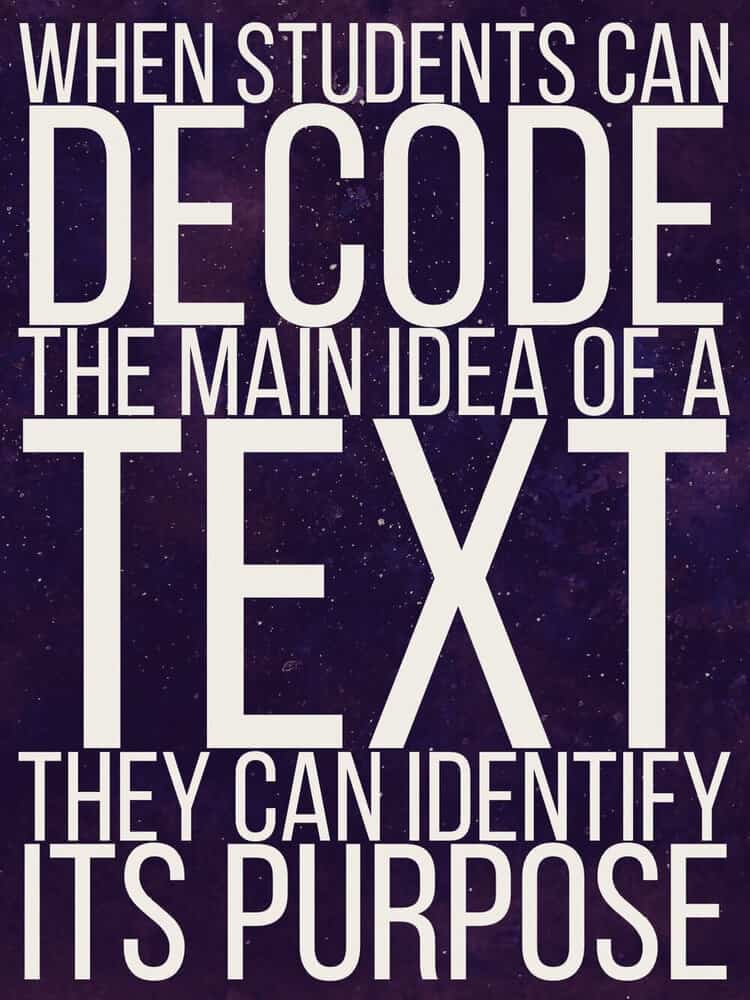
We have all been there, though it can often feel as futile as the search for that proverbial needle in a haystack…
Finding the main idea of a piece of writing can be challenging, but it is an essential reading comprehension skill for our students to develop. Students that become skilled in this art will benefit from it far beyond the perimeters of the school gates. From the small print of an insurance document to writing a book review, the ability to filter a text and identify its central idea is as much a crucial life skill as an essential literacy-based learning objective. Though it isn’t always easy, luckily, there is much we can do to help our students hone their abilities in this area.
WHAT IS ‘THE MAIN IDEA’? DEFINITION
Whether we are talking about the main idea of a paragraph, a poem, a chapter, or a longer text, finding the main idea requires the reader to identify the topic of a piece of writing and then uncover what the writer wants us to know about that topic.
As is so often the case, it is best to start small. When working with students on how to identify the main idea, begin by having students locate the main idea in a sentence before building up to locating it in a longer paragraph. As students gradually build their confidence in identifying the main idea in paragraphs, they will soon be ready to move on to longer texts in the form of chapters and eventually full-length books.
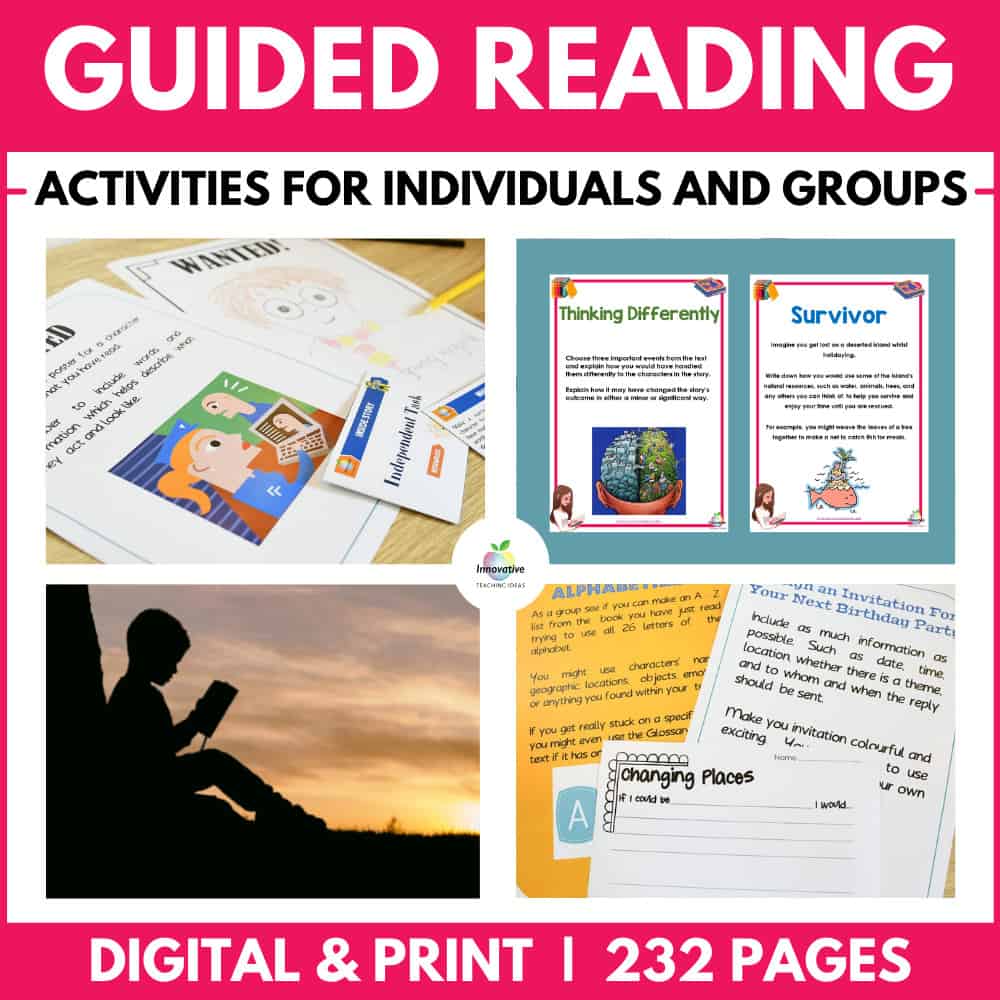
125 Guided Reading Activities
Ensure your students are constantly engaged with these INDEPENDENT & GROUP Reading Activities for ANY BOOK.
⭐⭐⭐⭐⭐ ( 215 reviews )
A WORD ON PARAGRAPHS

The main idea of a sentence is usually fairly straightforward to identify. Often it is as simple as identifying the subject of the sentence. Whole chapters or books, on the other hand, can seldom be easily reduced to expression in the form of a single, main idea. For these reasons, the paragraph offers the student the most suitable format in which to practice their main idea identification skills.
Usually, if the writer knows what they are doing, we can identify a single main idea in every paragraph. We can think of this as the key point that is usually expressed as a topic sentence. It is often found in the paragraph’s first sentence, with subsequent sentences providing the supporting details. It can, however, occur in the middle, at the end, or even be split across the paragraph. It may not even be there at all – at least not explicitly.
Writers are a creative bunch, and so students will require more sophisticated means to accurately identify the main idea in all cases and that is exactly what this article will help you help your students to do.
HOW IS A MAIN IDEA EXPRESSED?
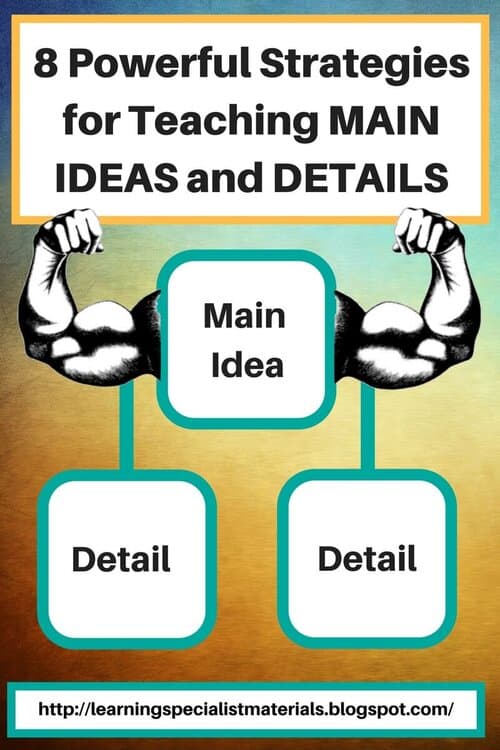
It can appear to be a reasonably clear-cut task to define the main idea, so why is it often so problematic for students to identify it? Well, the truth is that it needn’t be so. Often the central concept is expressed directly in the text and is as easy to identify as your own face in the mirror.
However, the main idea will not always be expressed so explicitly, and students must learn to identify it, whether it is expressed directly or merely implied, if they are to fully comprehend what they are reading.
THE STATEMENT OF THE MAIN IDEA
Attention is the key to pulling the main idea from a text, whatever the genre. Students need to identify the most relevant information from the work and use it to develop a statement expressing what they perceive as the main idea.
We can refer to this as The Statement of the Main Idea . This statement should be a lean sentence or two. The process of composing this statement starts with asking questions about the text. Not all questions will apply to every text, but they will provide a good starting point for extracting the main idea from any piece of writing.
● Who – Can the student identify the person or people the text is about?
● What – Can the student identify the topic or underlying theme of the text?
● When – Can the student identify a reference to a specific time or period?
● Where – Can the student identify a specific place or a setting ?
● Why – Can the student identify a reason or explanation for what happens in the text?
● How – Can the student identify a method or theory in the text?
These questions, and variations of these questions, can help students draw out what the text is about. The two most important questions of those above are who and what . These will sufficiently elicit the information required to identify the main idea in most circumstances. But, the actual litmus test of whether the student can absorb the text’s central idea is whether or not they can summarize what they have read in their own words.
The Litmus Test: Summarizing and Paraphrasing
We know through our experience in the classroom that learning through teaching is a highly effective instructional strategy. It also offers teachers opportunities to observe and assess their students’ grasp of the concepts they have been working on. Similarly, when we ask our students to summarize or paraphrase the main idea of an extract, we are creating an opportunity to observe their comprehension of what they have read and their ability to identify the main idea therein.
You can also encourage students to regularly practice these skills by challenging them to paraphrase and summarize things you have said or read to them in class, even during lessons entirely unrelated to literacy. Encourage them to be concise and to the point; you may even wish to set a word limit of 10 or 15 words within which they must express the main idea. Keep it lean!
STRATEGIES FOR SUCCESS IN IDENTIFYING THE MAIN IDEA
Get The Gist
In this method, give each student a copy of a nonfiction paragraph. If you wish, you can differentiate for students’ different abilities by choosing extracts of varying complexities. Regardless of the level of difficulty, the approach will remain the same. Have students:
1. Ask themselves who or what the paragraph is about.
2. Ask themselves what is the most essential information about the who or what.
3. Restate the main idea in 10 words or less.
You can model this strategy for your students by first walking them through the process. Project the text onto the whiteboard for shared reading and, with focused support and prompting, have them answer the initial questions.
Part 3 of the process above can be undertaken as a piece of shared writing which will model the correct approach before students begin to do it independently. Later, when students have written independent statements of the main idea, they can compare their responses and offer each other feedback. After feedback sessions, they can be given a further opportunity to redraft and modify their statements for accuracy and brevity.
Through these processes, students will improve their ability to identify and express the main idea clearly and concisely.
Get the Gist – Longer Texts
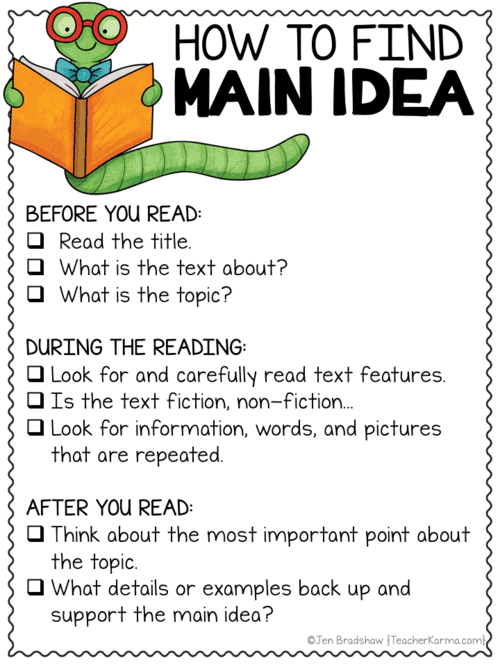
As we mentioned earlier, it isn’t always easy to reduce a longer extract, such as a chapter, down to a single central idea – much less a whole book! There will be times, however, when students will be asked to do just that. They will need a systematic approach to help them in such circumstances. The following process provides for a practical approach:
1. Look at the title – Often, the title provides a good indication of the topic of the text or at least helps to orientate the reader in the direction of the main idea.
2. Look at the extract’s first and last sentences/paragraphs – Often, the main idea will be introduced and summarized respectively in these parts of the text.
3. Look for repeated words and phrases in the extract -The frequency with which they occur will be a strong indicator of their relative importance and will point students toward that elusive main idea.
4. Instruct students to ask themselves, “ What does the writer want me to know? ” – Answering this question successfully will require them to uncover the text’s main idea.
As the students work through the above steps, they can highlight, underline, or circle the keywords and phrases and then use these to help them form their main idea statement.
HOW TO LOCATE THE MAIN IDEA WHEN IT IS IMPLIED
Inferring the main idea requires students to look for patterns in the details as they read. When the main idea is explicit, the student must first identify the topic of the writing before determining what it is the writer wants the reader to know about it. If the main idea is not stated explicitly in a sentence or paragraph, then it is implied, and students must consciously work to uncover it by analysing the details to infer the main idea. Conscious practice of this strategy will soon see it become second nature, and the student will quickly become skilled in identifying the main idea even when it is not stated explicitly.
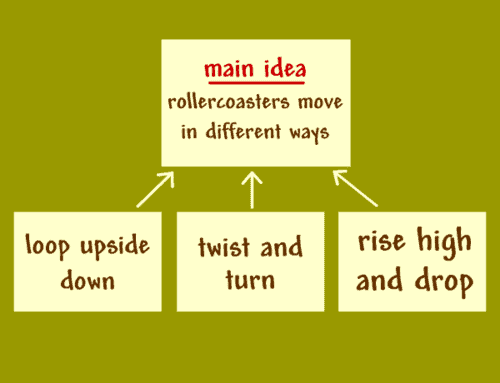
To efficiently identify the main idea in a piece of writing, students should first determine the text’s topic. Then, they will need to work out what it is the writer wants us to understand about that topic. This is the essence of how to identify the main idea.
Students should understand that the main idea may not always be explicit, and they may need to work hard to uncover precisely what the text implies. Regardless of whether the main idea is explicit or implicit, every paragraph will have the main idea. Students should understand that it can be located at the beginning, in the middle, at the end, or even be split up throughout the paragraph.
With perseverance and hard-earned experience, students can use various methods and, at times, a fusion of these methods to uncover the main idea with speed and accuracy. Soon they will be able to apply these methods to a broad range of texts over a wide range of lengths and complexities.

Teaching Resources
Use our resources and tools to improve your student’s writing skills through proven teaching strategies.
MAIN IDEA GRAPHIC ORGANIZER (FREE DOWNLOAD)
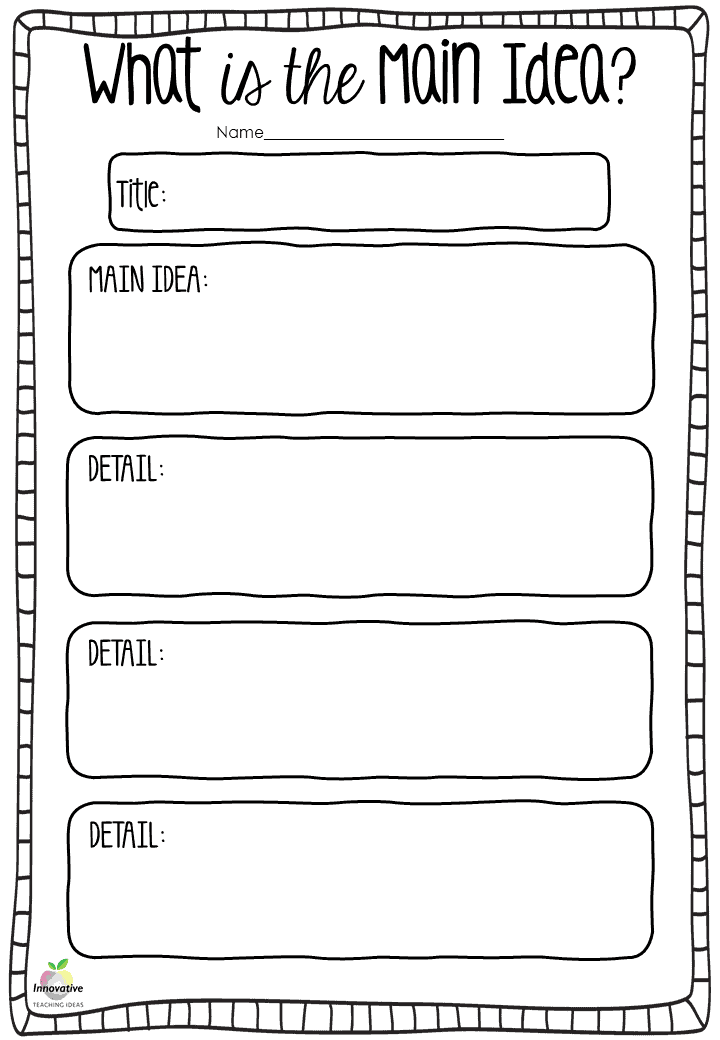
VIDEO TUTORIAL ON TEACHING THE MAIN IDEA
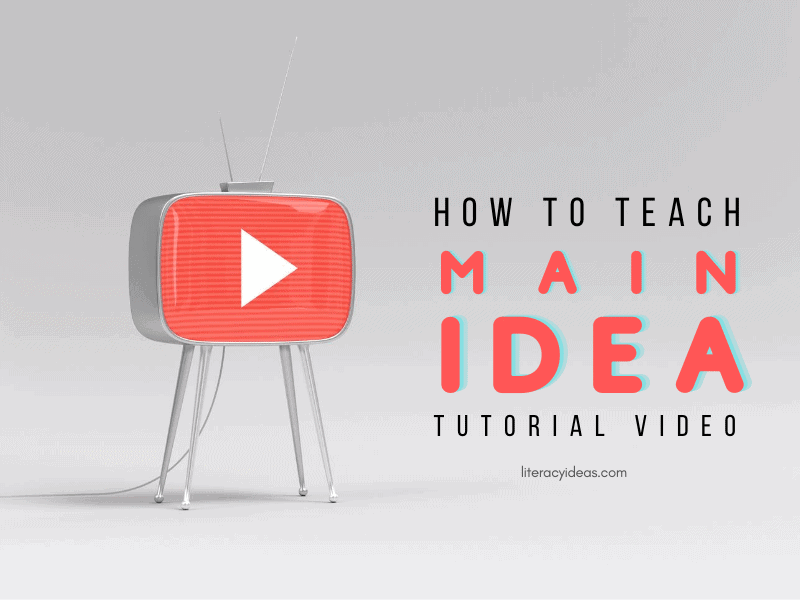
ARTICLES RELATED TO THE MAIN IDEA OF THE STORY
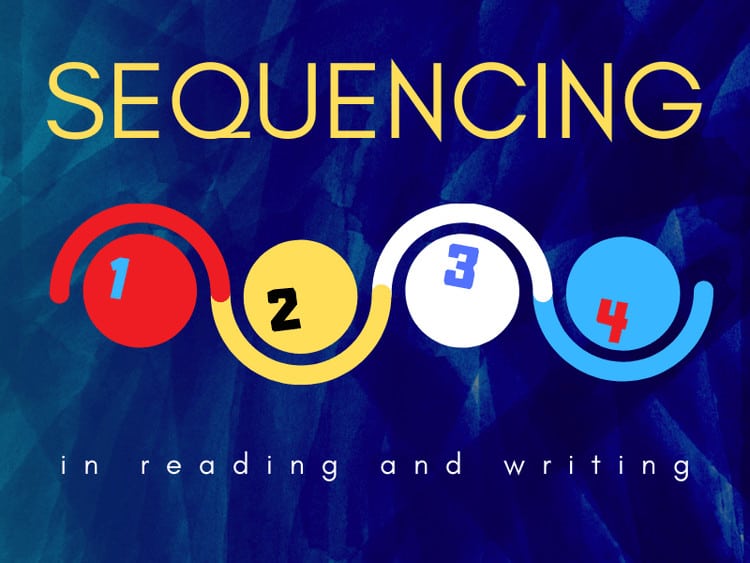
Sequencing events in reading and writing

Teaching Cause and Effect in Reading and Writing
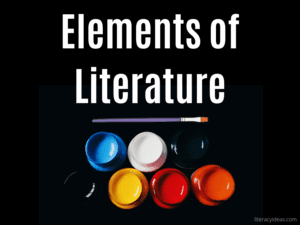
Elements of Literature

Teaching Compare and Contrast
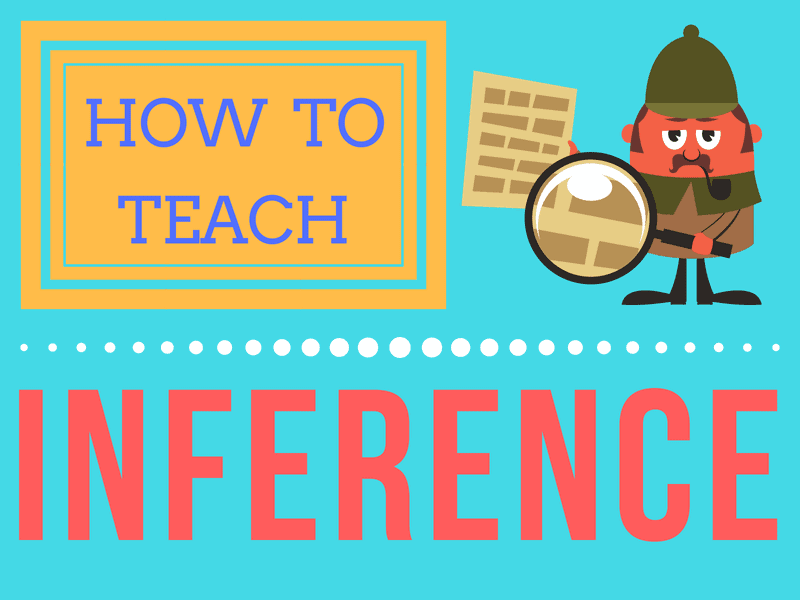
What Is An Inference? And How To Teach It.
Identifying Main Ideas
A main idea is the most important thought on your topic. So let’s get into how to spot, and create, a really good one!
Explicit Main Idea
A main idea is the author’s controlling point about the topic. It usually includes the topic and the author’s attitude or opinion about the topic. To identify the main idea, ask yourself:
- Who or what is the paragraph about? The answer is the topic . The topic can be stated in just a few words.
- What does the author think about the topic? The answer is the point. The point can also be stated in just a few words.
Once you’ve identified these pieces, you can combine them to state the author’s main idea in a single sentence.
Topic + Point = Main Idea
Topic = the cool-down period
Point = important parts of exercise workouts
( Topic + Point = Main Idea )
The cool-down period is an important part of an exercise workout .
Placement of Main Ideas & Topic Sentences
Often, but not always, the main idea of a paragraph is written as that paragraph’s topic sentence . A topic sentence is a single sentence that states the topic and words that qualify the topic by revealing the author’s opinion about the topic or the author’s approach to the topic and also reveal the author’s thought pattern or organizational strategy. When you’ve identified both the main idea and the thought pattern, you can identify the topic sentence.
Main Idea = The cool-down period is an important part of an exercise workout
Thought Pattern = several reasons
The cool-down period is an important part of an exercise workout for several reasons .
Main Idea + Thought Pattern = Topic Sentence
Below are more examples of how to craft topic sentences.
General to Specific
The topic sentence is the one sentence that is general enough to include all the ideas in the paragraph. Therefore, a topic sentence that begins a paragraph or appears within the first few sentences of a paragraph signals a move from general ideas to specific ideas.
Specific to General to Specific
At times, an author begins a paragraph with details to stir the reader’s interest in the topic. The flow of ideas moves from the specific to the general and back to the specific.
Specific to General
Sometimes, an author waits until the end of the paragraph to state the topic sentence and main idea. This allows the details to build up to the main idea and is sometimes called “climactic order.”
Implicit Main Idea
Implicit main idea refers to a main idea that is not stated directly but is strongly suggested by the supporting details in the passage. Many paragraphs in college textbooks do not provide a topic sentence, instead using supporting details to imply the main idea. To determine the implied main idea, look at:
- The supporting details: facts, examples, descriptions, and explanations given
- The author’s thought pattern
- The author’s purpose
Read the sample paragraph below:
Egypt’s pyramids are the oldest existing buildings in the world. These ancient tombs are also among the world’s largest structures. The largest pyramid stands taller than a 40-story building and covers an area greater than that of ten football fields. More than 80 pyramids still exist, and their once-smooth limestone surfaces hide secret passageways and rooms. The pyramids of ancient Egypt served a vital purpose: to protect the pharaoh’s bodies after death. Each pyramid held not only the pharaoh’s preserved body, but also all the goods he would need in his life after death.
1.The topic of the paragraph is pyramids
2. There are three groups of supporting details: age, size, and purpose
3.The author has organized the supporting details into “characteristics” or “traits” of the pyramids.
4.The author purpose seems to be trying to define a pyramid.
Implied Main Idea: Pyramids are structures with several distinctive traits.
Remember, the main idea must be broad enough to cover all the details in the paragraph without being so broad that it includes details not mentioned.
Michael|2019
This work is licensed under the Creative Commons Attribution-NonCommercial-ShareAlike 4.0 International License. To view a copy of this license, visit http://creativecommons.org/licenses/by-nc-sa/4.0/.

How to find the main idea
Determining the main idea of any text can be tricky. Let’s take a look at some helpful ways to zero in on it.

Author Taylor Hartley
Published January 19, 2024

Published Jan 19, 2024
- Key takeaways
- Think of the main idea as the point – The main idea is the primary argument or claim discussed by the author, around which all other supporting details and explanations revolve.
- Make sure you read the full text – You can determine the main idea by reading the full text, annotating its key points, summarising, and looking for any repeating ideas or statements.
- There are a few key questions to ask – While reading, it’s always important to look for the Who, What, Where and Why. These details will help explain why the author believes what they do.
Table of contents
What exactly is the main idea?
How to find the main idea in five easy steps.
- Questions to ask when trying to find the main idea
- Watch out for distractors
The main idea of a text can be a difficult thing to nail down, but it’s the most important detail of any passage you come across. As you travel along your journey towards mastering reading comprehension, you’ll need to build a habit of figuring out what the main idea is. Once you’ve accomplished that, you’ll have a better chance at consistently understanding even the most complicated of paragraphs.
The main idea is the central argument or point a paragraph is trying to communicate. It’s often the first claim an author makes when they begin their work but it can also be formed based on key details and facts dispersed throughout the body of a paragraph, too. Think of the main idea as the anchor of a paragraph, holding the passage steady and providing a foundation for other important points.
Is there a difference between the central idea and the main idea?
You might be a bit confused if you discover people referencing a “central idea,” of a paragraph or essay. But fear not! The central idea and the main idea are one and the same. The central idea represents the same key talking points and details as the main idea–the primary argument an author is trying to make.
Is there a difference between a supporting detail and a main idea?
Even though the central idea and the main idea are the same, there are a few differences between the main idea and it various supporting details. Supporting details are another important part of reading comprehension, as they provide some much needed context, or explanation of the overall main idea.
A supporting detail might go into greater detail on a specific topic, and give you a bit more understanding of the main point the author is trying to drive home. However, these supporting details don’t exist as their own main ideas, they’re simply there to support the main idea and reinforce it.
Now that you have a basic understanding of what the main idea is, you’ll need to start learning ways to identify it when you encounter it in the wild. Follow along as we walk through some helpful tips on pinpointing the main idea of a passage.
1. Identify the topic.
One of the first tools you can use for locating the main idea is referencing the title of a paper or any subtitles used throughout. Titles are a great way of gaining a grasp on the central topic of an author’s argument. Take the title of this article, “How to find the main idea.” We can learn a lot about what a piece of writing is about by looking at its title.
2. Read the entire passage.
The second step in finding the main idea? You guessed it, thoroughly read the passage so you can get a firm handle on what it’s trying to say. You might be tempted to skim the writing to save time, but it’s important to read each sentence with intent so no details go unseen. Remember, even the smallest detail can provide you with the extra confidence and understanding you need to define the main idea.
3. Annotate as you go, underlining key points or ideas you see.
One helpful tip to help guide your understanding of the main idea is to annotate, or take notes, while you read the text. Doing this will give you a brief but helpful outline of the main points the passage makes. You can look back through your notes once you’re done reading and use them to solve the main idea puzzle. Remember to write down any details you find particularly impactful.
4. At the end, summarise the passage and what you think it’s arguing.
When you’re finished reading and annotating, use what you’ve learned from the text to form a summary of the entire passage. Your summary should include the main arguments and supporting evidence the author used to get their point across. By creating a summary, you’ve reinforced the main ideas of the text in your head, making it easier to discover what the author is really trying to say.
5. Read the first sentence and last sentence and look for repeating ideas in your annotations.
The main idea is often expressed in the first few lines of a text and reiterated in the closing lines of a passage. Knowing this, take a good look at both the first and last lines of a paragraph, and see if there are any recurring details or statements within each one. If there are similarities, there’s a good chance that these statements reflect what the main idea is.
Questions to ask when trying to find the main idea
Although it’s important to take note of each detail you come across in a passage, some can be more valuable when trying to determine the main idea. These details are key parts of the summary you’ll need to create. They’re known as the Who, the What, the Where, and the Why.
The Who relates to the subject of the text; the person or thing the passage is describing. It’s most often a person or group of people, but it can also range from animals to robots to insects! Identifying the Who is an important part of grasping the main idea, because you’ll need to determine just who the author is writing about if you’re going to figure out what the author is trying to say about them.
What is happening within the passage? What actions are taken by the Who? These actions, or reactions, are known as the What. This is the meat of the paragraph, the behaviours or movements of characters and people that the author uses to describe what’s happening in their writing.
The When is another important detail you’ll need to define as you discover the main idea. The When of a passage is the time period the paragraph itself takes place in or references. Think of the When as a date on a calendar. The Who and What you’ve already defined, but on what date – or at what time of the day – do they appear?
What is the setting or location of the paragraph? Where does the action take place? Is it in a specific state or country, or maybe a specific city or neighbourhood? By defining the Where, you’ll be able to determine how the setting influences the main idea. Maybe there are specific laws or rules tied to the setting that affect the main idea, or maybe the geography of the setting affects what the author is trying to say about the region and the people who live in it. No matter what the Where is, you need to define it so that you can understand how the setting of a passage relates to the main idea.
And most importantly, why?
The Why is perhaps the most important piece of the main idea puzzle. To define the Why, ask yourself how the author explains the reasoning behind their argument. Why do certain things work the way they do? Why do people act in the ways that they do? The answer to these questions are within the text, and they’re probably the most important facts regarding the main idea. If you can define the Why, or the explanation for why the author thinks the way they do, you can find the main idea.
Watch out for distractors
As you work your way through a multiple-choice test, reading comprehension questions will normally ask you to pick the main idea out from a collection of possible answers. The creators of these tests can be tricky, and might try to mislead you with answers that don’t actually align with the true main idea.
Because of this, it’s important that you read the passage carefully, paying close attention to the little details throughout that might clue you in to the main idea’s meaning. Make sure to come up with your own main idea, and don’t rely on the answers provided to you by the test. Wrong answers are often either too narrow in their description of the text, too broad, or make claims that are contrary to the argument posed by the author.
Creating your own outline of the passage once you’ve carefully read it will help you summarise the text, pick out its key arguments, and determine the best answer for what the main idea is.
Explore the main idea with DoodleEnglish
DoodleEnglish is an app that’s filled with thousands of fun, interactive exercises covering grammar, punctuation, spelling and more!
Designed by teachers, it creates each child a unique work programme tailored to their needs, boosting their confidence and skills in English. Try it for free today!

FAQs about the main idea
The main idea should include the main talking points of a paragraph. Think of it as a summary of the author’s writing that represents their central argument. The main idea includes the key statements, facts, or opinions the author chooses to include that embody what they’re trying to say.
There are several strategies you can use to help you find the main idea. Techniques such as looking at the title of the work, or any subtitles, writing down your own summary of the text, looking at the first and last sentences of a paragraph, and identifying recurring ideas are ways to discover the main idea. You can also take notes throughout your reading so that you have a brief outline of key details.
Yes, it’s extremely important for you to read the passage in its entirety if you want the best chance at understanding its main idea. You may feel tempted to skim or speed-read your way through an essay, but be wary that you might miss certain details or key ideas that could have helped you define the central argument. The best way to go about defining the main idea is to read each sentence intently.
The central claim and the main idea are synonymous with one another, meaning they represent the same thing. If you’ve identified the central claim of a passage, you’ll be happy to know that you’ve also found the main idea!

Try DoodleEnglish for free!

Related posts
What are speech marks?

From novels to news reports, speech marks are used everywhere
Spelling activities for KS2

There are lots of fun ways you can liven up spelling practice!
What is SPaG? A guide

SPaG is a really important concept in English, but what does it mean?
What we offer
Quick links
All rights reserved.

Are you a parent, teacher or student?
Get started for free!
Maths information pack
We ask for your contact info so we can send our info pack directly to your inbox for your convenience, exam prep information pack, case studies information pack.
Book a chat with our team

I’m new to Doodle

My school is already using Doodle

Information pack
We ask for your contact info so that our education consultants can get in touch with you and let you know a bit more about doodle., student login, which programme would you like to use.
DoodleMaths
DoodleTables
DoodleEnglish
DoodleSpell
If you’d like to use Doodle’s browser version, please visit this page on a desktop.
To log in to Doodle on this device, you can do so through our apps. You can find out how to download them here:
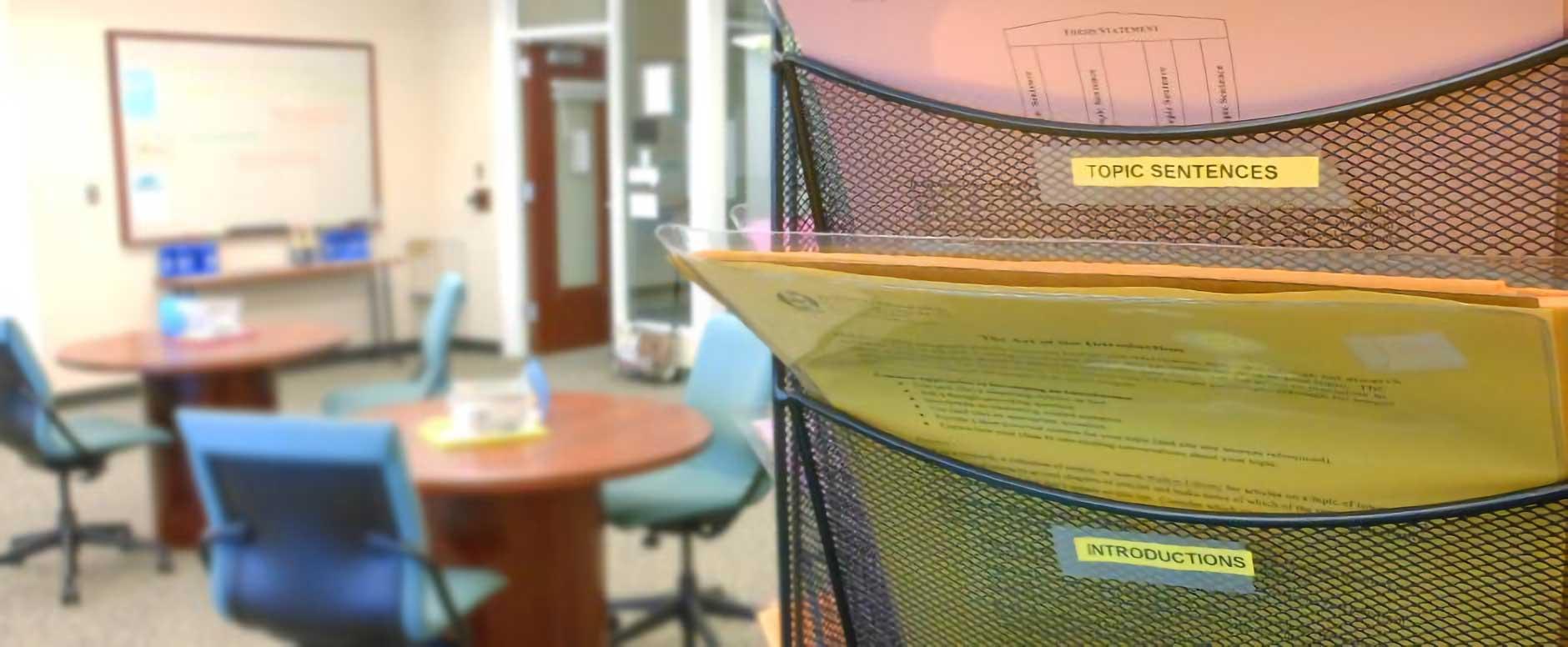
Margaret H. Ordoubadian University Writing Center at MTSU
University writing center, com 5: thesis statements.
Dynamic PDF: Thesis Statements
The thesis statement is perhaps the most crucial part of your essay because it presents the main idea or main argument of the piece of writing. In academic essays, your thesis statement is often located in the introductory paragraph; however, this is not always the case. Consider the rhetorical situation and assignment guidelines to determine where to best place your thesis.
What does a thesis statement do?
- Informs the reader how to interpret the paper’s significance
- Serves as a sign post for the essay, showing where the rest of the paper is headed
- Offers a unique perspective on the topic at hand
- Makes a claim or argument about a topic or issue
Creating a Thesis Statement
Once you have brainstormed about a topic, collected evidence to support your claims, and thought about the significance of your ideas, you should decide what you are arguing about the topic at hand. After this consideration, you’ll likely find yourself with a working thesis statement that expresses your main idea. You may have to write your thesis multiple times before you feel it captures all you want to say about your argument.
Remember, your thesis statement is different from the topic itself. For example, the topic of your paper might be “Running” or even “Why People Should Run.” Your thesis statement , however, will present an argument about running and explain the significance.
There are two types of thesis statements, blueprint and umbrella.
- A blueprint thesis lists what will be discussed in your paper (EX: Running is important because A, B, and C.). While blueprint thesis statements are sometimes appropriate, you may find them limiting, especially for longer papers.
- An umbrella thesis presents an overview of your argument without listing all of the individual components. An umbrella thesis allows you to express your argument in a condensed, concise way (EX: People who are interested in starting an exercise program should consider running because of the instant health benefits, both physical and mental.) While we know this paper will argue that running provides physical and mental health benefits, the writer does not have to list each one that will be discussed in the essay.
After you craft your thesis statement, ask yourself some questions about what your thesis statement accomplishes. This will help strengthen and clarify your main idea:
- Do I answer the question asked of me by this assignment?
- If this essay is argumentative, have I taken a clear position?
- Is my thesis statement specific enough?
- Does my thesis pass the “so what?” test? How is this idea related to a larger significance?
Remember, as you continue to develop your paper, your thesis statement may evolve. While your original thesis can serve as a guide, you should feel free to change your thesis based on the research you conduct or the ideas you further develop.
Office Phone
(615) 904-8237
Walker Library, Room 362
The Writing Center
Middle Tennessee State University
Murfreesboro, TN 37132
Read about our 45th Anniversary event and take a look at our growing digital archive !
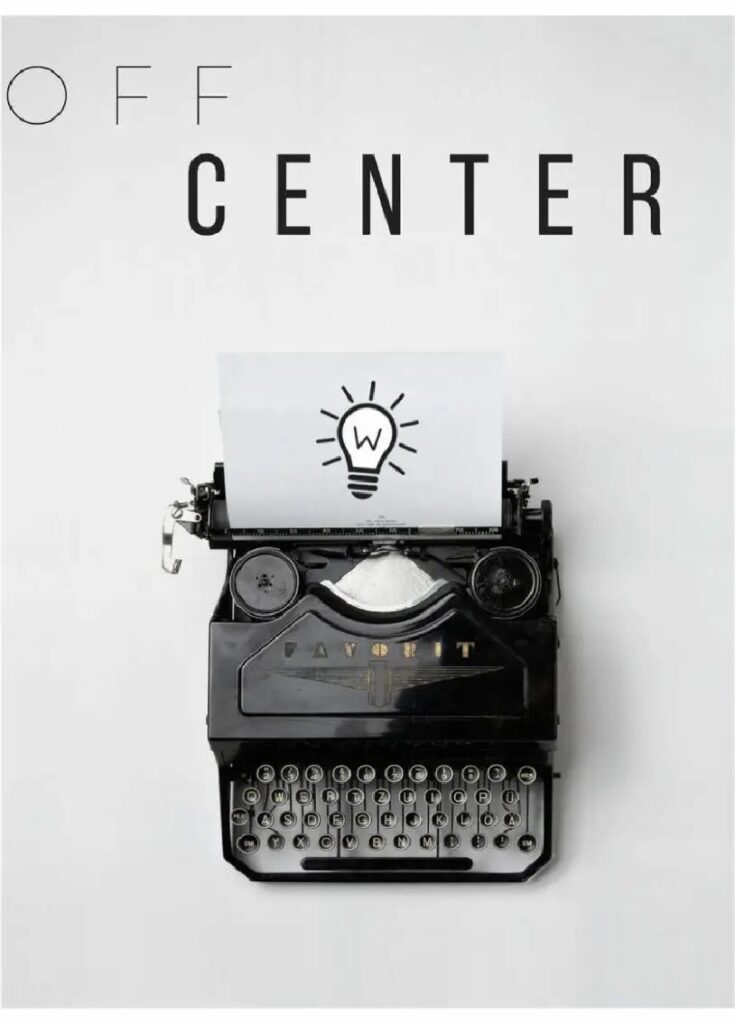
Check out the latest issue of Off Center Magazine!
If you're seeing this message, it means we're having trouble loading external resources on our website.
If you're behind a web filter, please make sure that the domains *.kastatic.org and *.kasandbox.org are unblocked.
To log in and use all the features of Khan Academy, please enable JavaScript in your browser.
Fifth grade reading skills
Course: fifth grade reading skills > unit 1, identifying the main idea | reading.
- What is a main idea? | Reading
What's the main idea?
- Which choice best captures the central idea of the passage?
- What is the author's main point in this passage?
- The main idea of the passage is...
What ISN'T the main idea?
- Look for clues in the title, the first sentence, and the last sentence of a passage. The author might state the main idea right at the beginning of the passage.
- Jot quick notes to yourself on scratch paper as you read. Taking notes is always helpful for understanding a passage.
- Pay attention to repeated words or ideas. If the author keeps mentioning the same thing over and over, it's likely that it's the main idea.
- Summarize the passage in your own words. If you can boil the passage down to just one or two sentences, that's probably the main idea.
Want to join the conversation?
- Upvote Button navigates to signup page
- Downvote Button navigates to signup page
- Flag Button navigates to signup page

- school Campus Bookshelves
- menu_book Bookshelves
- perm_media Learning Objects
- login Login
- how_to_reg Request Instructor Account
- hub Instructor Commons
Margin Size
- Download Page (PDF)
- Download Full Book (PDF)
- Periodic Table
- Physics Constants
- Scientific Calculator
- Reference & Cite
- Tools expand_more
- Readability
selected template will load here
This action is not available.

3.8: Main Ideas and Supporting Details
- Last updated
- Save as PDF
- Page ID 31307

- Athena Kashyap & Erika Dyquisto
- City College of San Francisco via ASCCC Open Educational Resources Initiative
\( \newcommand{\vecs}[1]{\overset { \scriptstyle \rightharpoonup} {\mathbf{#1}} } \)
\( \newcommand{\vecd}[1]{\overset{-\!-\!\rightharpoonup}{\vphantom{a}\smash {#1}}} \)
\( \newcommand{\id}{\mathrm{id}}\) \( \newcommand{\Span}{\mathrm{span}}\)
( \newcommand{\kernel}{\mathrm{null}\,}\) \( \newcommand{\range}{\mathrm{range}\,}\)
\( \newcommand{\RealPart}{\mathrm{Re}}\) \( \newcommand{\ImaginaryPart}{\mathrm{Im}}\)
\( \newcommand{\Argument}{\mathrm{Arg}}\) \( \newcommand{\norm}[1]{\| #1 \|}\)
\( \newcommand{\inner}[2]{\langle #1, #2 \rangle}\)
\( \newcommand{\Span}{\mathrm{span}}\)
\( \newcommand{\id}{\mathrm{id}}\)
\( \newcommand{\kernel}{\mathrm{null}\,}\)
\( \newcommand{\range}{\mathrm{range}\,}\)
\( \newcommand{\RealPart}{\mathrm{Re}}\)
\( \newcommand{\ImaginaryPart}{\mathrm{Im}}\)
\( \newcommand{\Argument}{\mathrm{Arg}}\)
\( \newcommand{\norm}[1]{\| #1 \|}\)
\( \newcommand{\Span}{\mathrm{span}}\) \( \newcommand{\AA}{\unicode[.8,0]{x212B}}\)
\( \newcommand{\vectorA}[1]{\vec{#1}} % arrow\)
\( \newcommand{\vectorAt}[1]{\vec{\text{#1}}} % arrow\)
\( \newcommand{\vectorB}[1]{\overset { \scriptstyle \rightharpoonup} {\mathbf{#1}} } \)
\( \newcommand{\vectorC}[1]{\textbf{#1}} \)
\( \newcommand{\vectorD}[1]{\overrightarrow{#1}} \)
\( \newcommand{\vectorDt}[1]{\overrightarrow{\text{#1}}} \)
\( \newcommand{\vectE}[1]{\overset{-\!-\!\rightharpoonup}{\vphantom{a}\smash{\mathbf {#1}}}} \)

Analyze Thesis or Main Ideas of Texts
Being able to identify the purpose and thesis of a text, while you’re reading it, takes practice. Questioning the text you’re reading is a good place to start. When trying to isolate the thesis, or main idea, of your reading material, consider these questions:
- What is the primary subject of this text?
- Is the author trying to inform me, or persuade me?
- What does the author think I need to know about this subject?
- Why does the author think I need to know about this subject?
Sometimes the answer to these questions will be very clearly stated in the text itself. Sometimes it is less obvious, and in those cases, the techniques on the following page will be useful.
Implicit vs. Explicit Main Idea/ Thesis Statements
According to author Pavel Zemliansky,
Arguments then, can be explicit and implicit, or implied. Explicit arguments contain noticeable and definable thesis statements and lots of specific proofs. Implicit arguments, on the other hand, work by weaving together facts and narratives, logic and emotion, personal experiences and statistics. Unlike explicit arguments, implicit ones do not have a one-sentence thesis statement. Instead, authors of implicit arguments use evidence of many different kinds in effective and creative ways to build and convey their point of view to their audience. Research is essential for creative effective arguments of both kinds.
Even if what you’re reading is an informative text, rather than an argumentative one, it might still rely on an implicit thesis statement. It might ask you to piece together the overall purpose of the text based on a series of content along the way.
The following video defines the key terms explicit and implicit, as they relate to thesis statements and other ideas present in what you read. It also introduces the excellent idea of the reading voice and the thinking voice that strong readers use as they work through a text.
To help keep you on your toes, the author of this video challenges you to find her spelling mistake in one of her cards along the way!
Explicit v. implicit . Authored by: Michele Armentrout. All Rights Reserved. License Terms: Standard YouTube license.
Take the quiz about implicit and explicit thesis statements to see how well you have understood the information.
Thesis and Topic Sentences
You’ll remember that the first step of the reading process, previewing, allows you to get a big-picture view of the document you’re reading. This way, you can begin to understand the structure of the overall text. A later step in the reading process, summarizing , allows you to encapsulate what a paragraph, section, or the whole document is about. When summarizing individual paragraphs, it’s likely that your summary ends up looking like a paraphrase of that paragraph’s topic sentence .
A paragraph is composed of multiple sentences focused on a single, clearly-defined topic. There should be exactly one main idea per paragraph, so whenever an author moves on to a new idea, he or she will start a new paragraph. For example, this paragraph defines what a paragraph is, and now we will start a new paragraph to deal with a new idea: how a paragraph is structured.
Paragraphs are actually organized much like persuasive papers are. Just like a paper has a thesis statement followed by a body of supportive evidence, paragraphs have a topic sentence followed by several sentences of support or explanation. If you look at this paragraph, for example, you will see that it starts with a clear topic sentence letting you know that paragraphs follow a structure similar to that of papers. The next sentence explains how a paragraph is like a paper, and then two more sentences show how this paragraph follows that structure. All of these sentences are clearly connected to the main idea.
The topic sentence of a paragraph serves two purposes: first, it lets readers know what the paragraph is going to be about; second, it highlights the connection between the present paragraph and the one that came before. The topic sentence of this paragraph explains to a reader what a topic sentence does, fulfilling the first function. It also tells you that this paragraph is going to talk about one particular aspect of the previous paragraph’s main idea: we are now moving from the general structure of the paragraph to the particular role of the topic sentence.
After the topic sentence introduces the main idea, the remainder of the sentences in a paragraph should support or explain this topic. These additional sentences might detail the author’s position on the topic. They might also provide examples, statistics, or other evidence to support that position. At the end of the paragraph, the author may include some sort of conclusion or a transition that sets up the next idea he or she will be discussing (for example, you can see this clearly in the last sentence of the third paragraph).
The Three Parts of a Paragraph
The topic is the subject of the paragraph. It can be:
- A few words long
- These words (or words related to the topic) are typically repeated throughout the paragraph
- Answers the question: What is this paragraph about?
2) Main Idea
This is the writer’s overall point. It can be:
- If stated in the paragraph, it’s called a “topic sentence”
- If unstated in the paragraph, the reader must figure it out (infer it) from details
- General enough to cover the more specific supporting details
- Usually (but not always!) near the beginning of the paragraph
- Answers the question: What is the overall point being made about the topic?”
3) Supporting Details
These are the details in the paragraph that support the main idea. They can be either major or minor supporting details.
Tips for Identifying Main Ideas
Although you are learning to put the main idea first in your own paragraphs, professional writers often don’t. Sometimes the first sentence of a paragraph provides background information, poses a question, or serves as a bridge from a previous paragraph. Don’t assume it is the main idea. Use these tips instead:
- Look for a general statement that appears to “cover” the other information.
- Figure out the general topic of the paragraph first. Then ask yourself, “What point is the writer trying to make about this topic?”
- Look for clue words. Main ideas sometimes have words such as “some” or plural nouns like “ways” or “differences” that signal a list of details to come.
- Is this statement supported by most of the other information?
- If I turn this statement into a question, does the other information answer it?
SPECIAL NOTE: Sometimes a main idea covers more than one paragraph. This may happen in newspaper articles or when the writer has a lot to say about one topic.
Difference Between the Topic and Main Idea
To understand the difference between a main idea and the topic, imagine that you are listening to your friends talk about their pets. The TV is on, so all you can make out are the name of their pets. If someone asked you what the topic was, you would say “pets.” But because you couldn’t hear the whole thing, you didn’t understand the “main idea” was whose pet was the best. The topic is very broad – the main idea is more specific. The sentences that follow in the paragraph exercise offer examples or descriptions to illustrate or explain the main idea. Note the reading-writing connection--while we are finding the main idea as readers, we will be using the main ideas to write topic sentences in paragraphs.
Exercise \(\PageIndex{1}\)
Read the following paragraph and then decide what the main idea is.
One myth about exercise is that if a woman lifts weights, she will develop muscles as large as a man’s. Without male hormones, however, a woman cannot increase her muscle bulk as much as a man’s. Another misconception about exercise is that it increases the appetite. Actually, regular exercise stabilizes the blood-sugar level and prevents hunger pangs. Some people also think that a few minutes of exercise a day or one session a week is enough, but at least three solid workouts a week are needed for muscular and cardiovascular fitness.
Choose the Main Idea:
a) Women who lift weights cannot become as muscular as men.
b) There are several myths about exercise.
c) Exercise is beneficial to everyone.
d) People use many different excuses to avoid exercising.
Explain why you did or did not choose each possible answer above.
a) ________________________________________________________________________
________________________________________________________________________
b) ________________________________________________________________________
c) ________________________________________________________________________
d) ________________________________________________________________________
Exercise \(\PageIndex{2}\)
“To Sherlock Holmes she is always THE woman. I have seldom heard him mention her under any other name. In his eyes she eclipses and predominates the whole of her sex. It was not that he felt any emotion akin to love for Irene Adler. All emotions, and that one particularly, were abhorrent to his cold, precise but admirably balanced mind. He was, I take it, the most perfect reasoning and observing machine that the world has seen, but as a lover he would have placed himself in a false position. He never spoke of the softer passions, save with a gibe and a sneer. They were admirable things for the observer--excellent for drawing the veil from men's motives and actions. But for the trained reasoner to admit such intrusions into his own delicate and finely adjusted temperament was to introduce a distracting factor which might throw a doubt upon all his mental results.“
The main idea of this paragraph is the first sentence. The first sentence identifies the two characters that the rest of the paragraph is going to describe, and suggests at their relationship. Each sentence that follows either describes the woman, Sherlock Holmes, or how he felt about her or her effect on him.
Exercise \(\PageIndex{3}\)
Here is another example from the same story, see if you can find the main idea:
One night--it was on the twentieth of March, 1888--I was returning from a journey to a patient (for I had now returned to civil practice), when my way led me through Baker Street. As I passed the well-remembered door, which must always be associated in my mind with my wooing, and with the dark incidents of the Study in Scarlet, I was seized with a keen desire to see Holmes again, and to know how he was employing his extraordinary powers. His rooms were brilliantly lit, and, even as I looked up, I saw his tall, spare figure pass twice in a dark silhouette against the blind. He was pacing the room swiftly, eagerly, with his head sunk upon his chest and his hands clasped behind him. To me, who knew his every mood and habit, his attitude and manner told their own story. He was at work again.
a. One night--it was on the twentieth of March, 1888--I was returning from a journey to a patient (for I had now returned to civil practice), when my way led me through Baker Street.
b. As I passed the well-remembered door, which must always be associated in my mind with my wooing, and with the dark incidents of the Study in Scarlet, I was seized with a keen desire to see Holmes again, and to know how he was employing his extraordinary powers
c. His rooms were brilliantly lit, and, even as I looked up, I saw his tall, spare figure pass twice in a dark silhouette against the blind.
d. He was pacing the room swiftly, eagerly, with his head sunk upon his chest and his hands clasped behind him.
The correct answer is a. The first sentence gives you the point-of-view, or who is the person explaining what is happening, and it lets you know that this person is going into a particular place. Each of the other sentences describes the place where he, Dr. Watson, entered, what it looked like, and who was in there.
B is not as strong a choice as a, because it refers to Study in Scarlet and Holmes’ powers, which are not described in the rest of the paragraph. Choice B is too specific to be the main idea of this paragraph. Choices c and d are not correct because they are describing Holmes’ actions, and his walking is not what the whole paragraph is about.
Exercise \(\PageIndex{4}\)
Let’s try one more. Read the following and select which one is the main idea from the list below:
“At three o'clock precisely I was at Baker Street, but Holmes had not yet returned. The landlady informed me that he had left the house shortly after eight o'clock in the morning. I sat down beside the fire, however, with the intention of awaiting him, however long he might be. I was already deeply interested in his inquiry, for, though it was surrounded by none of the grim and strange features which were associated with the two crimes which I have already recorded, still, the nature of the case and the exalted station of his client gave it a character of its own. Indeed, apart from the nature of the investigation which my friend had on hand, there was something in his masterly grasp of a situation, and his keen, incisive reasoning, which made it a pleasure to me to study his system of work, and to follow the quick, subtle methods by which he disentangled the most inextricable mysteries. So accustomed was I to his invariable success that the very possibility of his failing had ceased to enter into my head.”
a. At three o'clock precisely I was at Baker Street, but Holmes had not yet returned.
b. The landlady informed me that he had left the house shortly after eight o'clock in the morning.
c. I sat down beside the fire, however, with the intention of awaiting him, however long he might be
d. I was already deeply interested in his inquiry, for, though it was surrounded by none of the grim and strange features which were associated with the two crimes which I have already recorded, still, the nature of the case and the exalted station of his client gave it a character of its own.
The way to figure out that the answer, this time, is d, is to look at each sentence that follows and ask, does this refer back to the location, Baker Street? Do they refer back to the landlady? Do they refer back to Dr. Watson’s waiting? Or, do they refer back to the case? They both refer back to the current investigation, by talking about Holmes’ way of untangling mysteries, and that Watson’s belief that the investigation would be a success.
The introduction to this paragraph may have thrown you off so be careful to read through the entire paragraph each time, and look at each sentence and its role within the paragraph. Mostly the main idea comes right up front – but not always!
Reading-Writing Connection: Thesis Statements
Exercise \(\PageIndex{5}\)
I. Develop a paragraph. Your paragraph must include the following:
- Between 7-9 sentences
- A main idea sentence
- Each sentence must be developed, and checked for correct spelling and grammar
- Have at least three of the four different types of sentences (simple, complex, compound, compound-complex)
- Attach your pre-writing practice after the paragraph, to identify which sentences are major and minor detail sentence
Supporting Details
Earlier we covered what a main idea sentence was: a sentence that names the topic, and allows the reader to understand the focus of the paragraph to follow. It is logical then that the rest of the sentences in the paragraph support the main idea sentence. Support means that they either explain something about the topic, or they offer an example.
We’ve examined the relationship between a text’s thesis statement and its overall organization through the idea of topic sentences in body paragraphs. But of course body paragraphs have a lot more “stuff” in them than just topic sentences. This section will examine in more detail what that “stuff” is made of.
First, watch this video that details the relationship between a topic sentence and supporting details, using the metaphor of a house. The video establishes the difference between major and minor details, which will be useful to apply in coming discussions. (The video has instrumental guitar for audio, but no spoken words, so it can be watched without sound if desired.)
Video: Supporting Details . Authored by: Mastering the Fundamentals of College Reading and Writing. All Rights Reserved. License Terms: Standard YouTube license.
The following image shows the visual relationship between the overall thesis, topic sentences, and supporting ideas:

This next image shows where a topic sentence might reside in the paragraph, in relation to the rest of the supporting details:

In #5 of the sequence above, the topic sentence is rephrased between the opening and closing of the paragraph, to reinforce the concept more strongly.
Point, Illustration, Explanation (P.I.E.)
Many authors use the PIE format to structure their essays. PIE = point, illustration, explanation to structure their body paragraph and support their thesis. The point furthers a thesis or claim and is the same as the main idea, the illustration provides support for the point, and the explanation tells the audience why the evidence provided furthers the point and/or the thesis.

For example, in his argument against the +/- grading system at Radford, student-writer Tareq Hajj makes the Point that “Without the A+, students with high grades in the class would be less motivated to work even harder in order to increase their grades.”
He Illustrates with a quote from a professor who argues, “‘(students) have less incentive to try’” (Fesheraki, 2013).
Hajj then Explains that “not providing [the most motivated students] with additional motivation of a higher grade … is inequitable.”
Through his explanation, Hajj links back to his claim that “A plus-minus grading scale … should not be used at Radford University” because, as he explains, it is “inequitable.” The PIE structure of his paragraph has served to support his thesis.
All Claims Need Evidence
Ever heard the phrase “everyone is entitled to his opinion”? It is indeed true that people are free to believe whatever they wish. However, the mere fact that a person believes something is not an argument in support of a position. If a text’s goal is to communicate effectively, it must provide valid explanations and sufficient and relevant evidence to convince its audience to accept that position. In other words, “every author is entitled to his opinion, but no author is entitled to have his opinion go unchallenged.”
What are the types of evidence?
Any text should provide illustrations for each of its points, but it is especially important to provide reliable evidence in an academic argument. This evidence can be based on primary source material or data (the author’s own experience and/or interviews, surveys, polls, experiments, that she may have created and administered). Evidence can also stem from secondary source material or data (books, journals, newspapers, magazines, websites or surveys, experiments, statistics, polls, and other data collected by others).
Let’s say, for example, that you are reading an argument that college instructors should let students use cell phones in class. Primary source material might include a survey the author administered that asks students if policies forbidding cell phone usage actually stop them from using their phones in class. Secondary sources might include articles about the issue from Faculty Focus or The Chronicle of Higher Education .
Logos, Ethos, Pathos
Writers are generally most successful with their audiences when they can skillfully and appropriately balance the three core types of appeals. These appeals are referred to by their Greek names: logos (the appeal to logic), pathos (the appeal to emotion), and ethos (the appeal to authority). All of these are used in one way or another in your body paragraphs, particularly as it relates to the support or information in the paragraph.
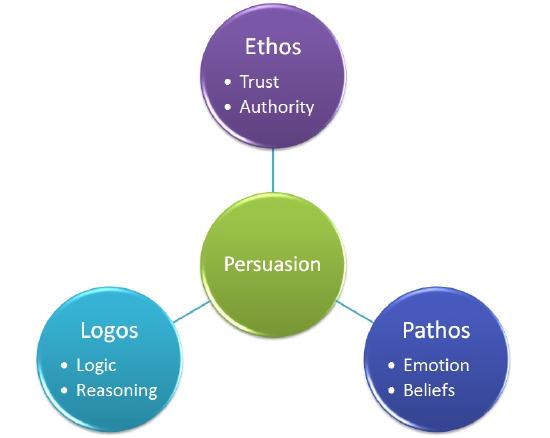
Logical Appeals
Authors using logic to support their claims will include a combination of different types of evidence. These include the following:
- established facts
- case studies
- experiments
- analogies and logical reasoning
- citation of recognized experts on the issue
Authoritative Appeals
Authors using authority to support their claims can also draw from a variety of techniques. These include the following:
- personal anecdotes
- illustration of deep knowledge on the issue
- testimony of those involved first-hand on the issue
Emotional Appeals
Authors using emotion to support their claims again have a deep well of options to do so. These include the following:
- impact studies
As you can see, there is some overlap on these lists. One technique might work simultaneously on multiple levels.
Most texts rely on one of the three as the primary method of support, but may also draw upon one or two others at the same time.
Check your understanding of supporting details by doing this quiz.
Exercise \(\PageIndex{6}\)
Read the paragraph below and find the main idea and supporting details.
My parents were very strict when I was growing up. My mother in particular was always correcting my behavior. One day when I forgot to look both ways when I was crossing the street, my mother made me go back home; she said that I could not go out at all if I could not be safe. My father was more concerned with my grades. Every night he would make me go to my room before I could watch television.
Let’s examine the pattern for this paragraph. The first sentence (1) presents the main idea, that my parents were strict. The second sentence (2) explains what I mean by “strict,” by saying that my mother was strict in correcting my behavior. The third sentence (3) offers an example of how she would correct my behavior. The fourth sentence (4) explains further, that my father was strict when it came to schoolwork, and then the fifth sentence (5) offers an example of how he was strict.
If we were going to diagram the paragraph above, it would look like this:
EXPLAIN (2)-___________________EXPLAIN (4)
EXAMPLE (3) EXAMPLE (5)
Major and Minor Supporting Details
One way to talk about whether a sentence directly supports the main idea (the second level), or indirectly supports the main idea (the third level) is to call them MAJOR detail sentences or MINOR detail sentences. Major details directly explain something about the topic, while minor details offer examples for the Major detail that came right before.
Exercise \(\PageIndex{7}\)
Read the paragraphs, and then identify each sentence as either a main idea, a major detail, or a minor detail sentence.
Single parents have to overcome many obstacles to return to school. If the child is very young, finding quality babysitting can be difficult. Many babysitters are unreliable and that can mean that the parent has to miss many classes, which can hurt their grades. It is also hard to find enough time to study. Children require a lot of attention and are also noisy, and that can interfere with a parent's ability to complete their homework. Finally, raising children is expensive. Many single parents discover that they can’t meet the costs of both raising children and paying for tuition, books, and fees.
Sentence #1: Sentence #2: Sentence #3: Sentence #4: Sentence #5: Sentence #6: Sentence #7:
My grandmother turned 70 last year and celebrated by going skydiving. She said she always wanted to try and figured it was now or never. Many people think that when you get older you can no longer do fun things, but this is not true. The senior center in town offers dance lessons and also takes groups to the art museum. The classes are always full because so many people want to try new things. Towns are even developing senior living communities around activities such as golf and tennis. Those communities are very popular because people like to live with others who share their interests.
Sentence #1: Sentence #2: Sentence #3: Sentence #4: Sentence #5: Sentence #6: Sentence #7
Exercise \(\PageIndex{8}\)
Below you will find several main idea sentences. Provide appropriate supporting sentences following the pattern of Major-Minor-Major- Minor.
1. It is not a good idea to watch a lot of television. Major: Minor: Major: Minor:
2. Coaches have good reasons to be firm with the players on their team. Major: Minor: Major: Minor:
3. Many people believe it is a bad idea to spank children. Major: Minor: Major: Minor:
4. There are several steps I can take to be successful in college.
Major: Minor: Major: Minor:
Reading-Writing Connection: Supporting Details
Exercise \(\PageIndex{9}\)
Return to the Thesis exercise you did previously. As part of that exercise, you identified two topic sentences from your selected reading. Now, look more closely at the paragraphs where those two topic sentences came from.
- Write a paragraph that identifies the type of support that each paragraph from the reading uses to reinforce each of those two topic sentences. Are they narrative or personal examples? Are they facts or statistics? Are they quotes or paraphrases from research materials?
- Write another paragraph that compares the effectiveness of the supporting claims of one of the selected paragraphs against the other one. Which seems more successful in its goal? Why do you feel that way?
Contributors
- Adapted from English 9Y Pre-College English . Provided by: Open Course Library. CC BY 3.0
- Adapted from Thesis Statements and Topic Sentences . Provided by: Lumen Learning. CC-BY-NC-SA
- Adapted from Methods of Discovery: A Guide to Research Writing . Authored by: Pavel Zemliansky. Provided by: Libretexts. CC BY: Attribution
This page last updated June 6, 2020.
Finding the Main Idea – Reading Comprehension Strategy Lesson Plan
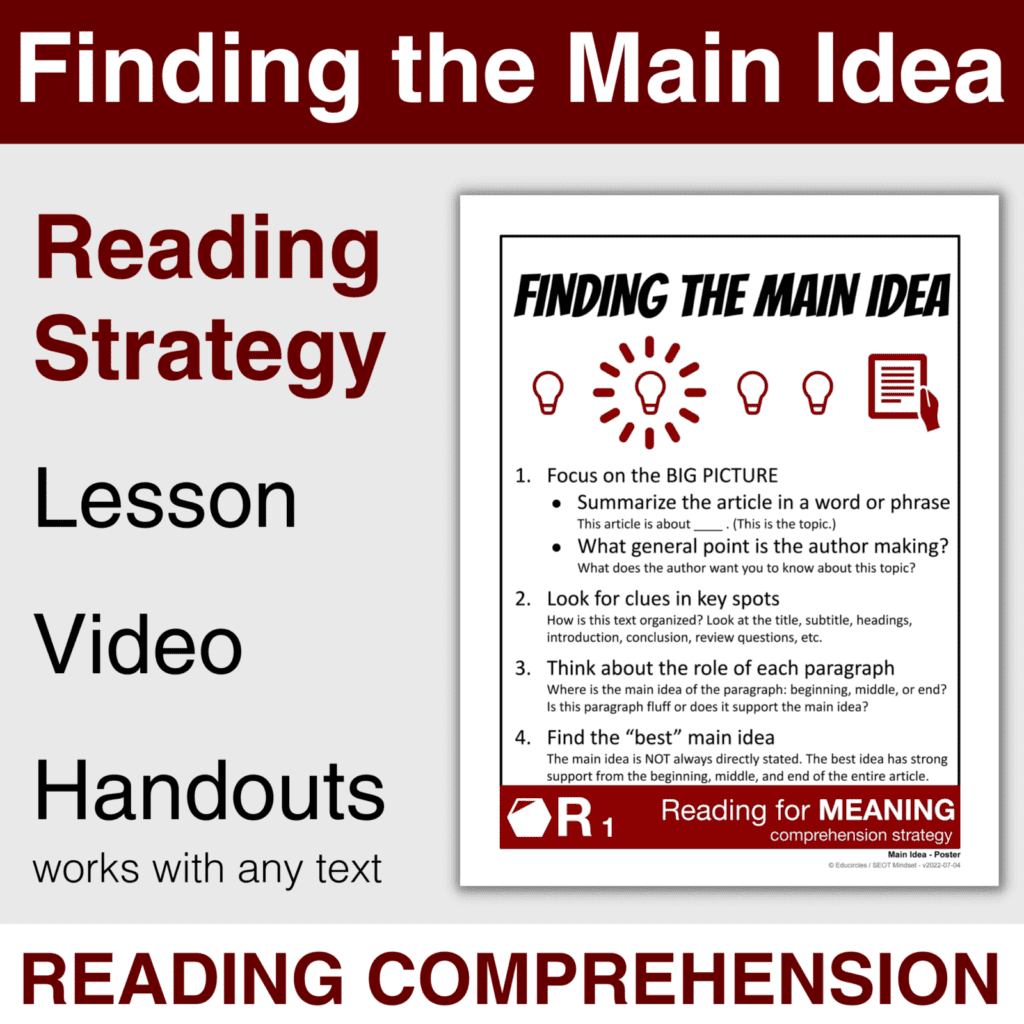
Finding the Main Idea lesson plan UPDATE Nov 21, 2022
Finding the Main Idea is more than just figuring out what general point the author is trying to make.
It’s about recognizing that we can come up with several main ideas, but the “best” main idea has strong support from the entire article.
Use this lesson to give students a process to find clues in the organization of the text.
Active reading means looking at the information in each paragraph and deciding if it is “nice to know” side information or essential information that develops the author’s point.
FINDING THE MAIN IDEA Reading Strategy
How to evaluate and find the best main idea (4 pro tips):.
- Focus on the BIG PICTURE (the entire article). Summarize the entire article in a word or phrase. What general point is the author trying to make?
- Look for clues in key spots. (How is the text organized?)
- Think about each paragraph. What is this paragraph about? (Where is the main idea in the paragraph? Beginning? Middle? End?) What role does this paragraph play?
- Find the “best” main idea. The main idea is NOT always directly stated. The best idea has strong support from the beginning, middle, and end of the entire article.
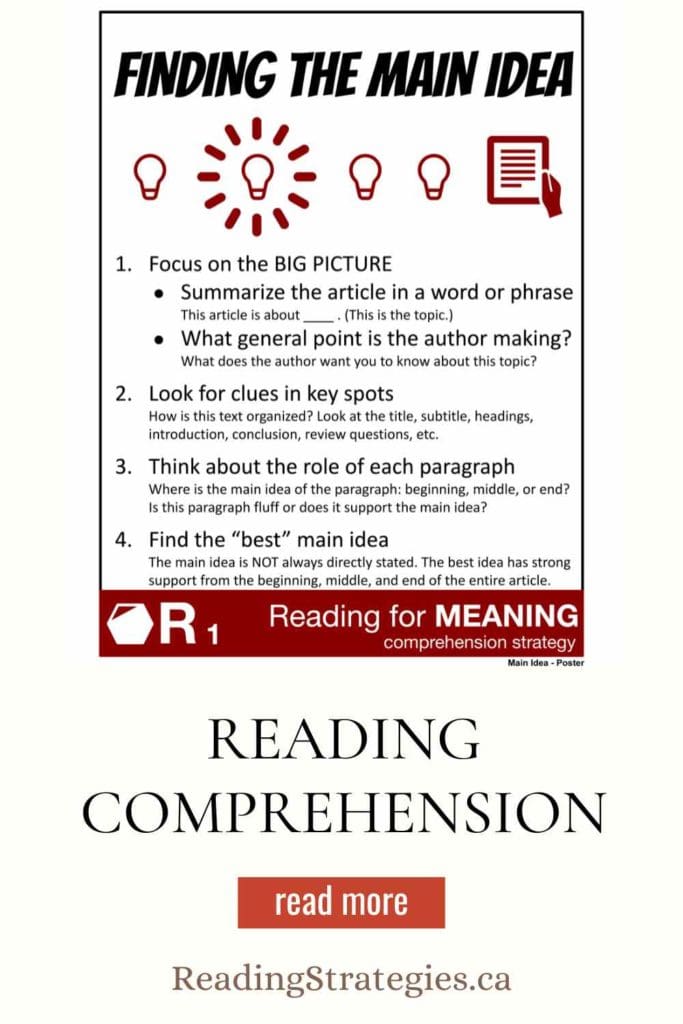
If you want this product with reading texts, please check out our Reading for Meaning Comprehension Strategies bundle.
Watch the FREE Reading Comprehension Video .
Hi everyone it’s Mike from Educircles and today is part of our Reading for Meaning series, we’re going to be talking about the comprehension strategy called Finding the Main Idea.
Now before we talk about this reading strategy , let’s review active reading.
- Active reading means we think about the text as we read.
- We don’t just say the words – we think about the words and what the words actually mean.
If we use strategies, we can get better at reading. Comprehension strategies help us figure out what is happening in a text.
Today, we will use a strategy called Finding The Main Idea.
Finding The Main Idea is about looking at the big picture of an article. We’re asking what general point is the author trying to make.
It’s not always easy to find the best or biggest main idea.
- The author will write several sentences and paragraphs – and in the article, there will be several key points and ideas.
- The best main idea is the overall central idea of the entire article.
- So, in this example, the big idea might be that this is a soup ladle.
Finding the main idea is like looking for constellations in the night sky.
A constellation is a group of stars in a recognizable pattern.
For example, this is the Big Dipper. If you know where to look it’s easier to see the patterns.
(Did you know that if you extend the line between the last 2 stars in the Big Dipper, you can find the North Star?)
When we read, we need to look for clues in key spots of the text.
- We need to ask ourselves, how is the text organized?
- We think about the big picture and we try to look at the entire article.
Here are 4 pro tips to help you find the main idea.
Find the main idea – pro tip #1: focus on the big picture.
Pro Tip #1 is to focus on the big picture – that means thinking about the entire article.
Summarize the entire article in a single word or phrase. What general point is the author trying to make about that topic?
We’re going to be looking at a series of examples.
Finding the Main Idea – Example #1: Photograph
Let’s look at example #1 which is a photograph.
- Here’s the photo.
- Summarize this entire media text in a single word or phrase.
- In other words, what is this image about?
What is the topic?
You might say stars, night, the universe, being alone, life on other planets…
Then, we have to ask ourselves what is the author saying about the topic. Maybe that “astronomy is the science of stars in space” or maybe the author is trying to say that “night is beautiful”, “the universe is expanding”, “being alone can be a good thing”, “Is there life on other planets?”
Any of these could be the main idea, but which one is the best main idea?
We need to try to figure out what is the photographer trying to say with this photo? Maybe the message is that “night is beautiful” or “being alone can be a good thing”. Or, maybe the photographer is trying to capture a sense of wonder about life on other planets. We need more information to figure out which of these might be the best main idea. Maybe there are other clues somewhere else.
Pro Tip #1 Recap
Let’s review Pro Tip #1.
Focus on the big picture – which means the entire article. Try to summarize the entire article in a single word or phrase. Ask yourself, what general point is the author trying to make.
Find the Main Idea – Pro Tip #2: Look for clues in key spots.
How is the text organized? Is there a title or subtitle? Are there headings or subheadings? Is there an introduction? Body paragraphs? A conclusion? Are there review questions?
Let’s look at example #2 which is an informational text that has 5 paragraphs.
Let’s zoom in.
Lorem ipsum is placeholder text that we use in web design. It gives us a sense of layout without having to use actual sentences. Many people just look for meaning in the sentences, but we can find a lot of clues hiding in the text organization.
That’s why in this lesson, there are fake words in the sentences. It’s to help us focus on the text form and structure instead of the words themselves.
Pro Tip #2 is about look for clues in key spots and the guiding question right now is how is the text organized?
Here’s the typical format for most informational texts.
- You have a title which gives us a big hint about the topic and the general point.
- The beginning of the article usually introduces what we’re going to find out in this article.
- The middle of the article usually includes supporting details that the author uses to explain their point
- Finally, at the end of the article, we often see a conclusion that summarizes what the author just told us.
Finding the Main Idea – Example #2: Five Paragraph Essay
This is a 5 paragraph essay.
- We have a catchy introduction to hook the reader.
- The last sentence in the introduction is usually the thesis or main idea and a quick introduction to the 3 ways the author is going to prove their point.
- Then in the body paragraphs, we have 3 ideas that prove the author’s point. We have reason #1, reason #2, and reason #3.
- Finally, in our conclusion paragraph, we usually restating the thesis – we restate our general point that we’re trying to make, and we briefly summarize our 3 reasons that we just told you about in the body paragraphs.
- We often finish our conclusion paragraph with a thought-provoking ending.
If we were doing a reading test on a 5 paragraph essay, we would know where to look in each paragraph and this could help us figure out the main idea of the essay.
The problem is most texts aren’t 5 paragraphs long.
Good writing is not always obvious and formulaic, but there are still patterns in how informational texts are organized. And we can use these patterns to help us figure out the main idea.
So, let’s look at example #3 which is an informational text that now has 20 paragraphs.
We’re going to start with our 5 paragraph essay and then add a bunch of line breaks. This means that if we were working on this article on our computer, we would literally hit the enter key to break apart longer paragraphs into shorter paragraphs.
We’re going to play with the structure of our paragraphs. Website articles typically use shorter paragraphs because shorter paragraphs are easier to read online.
- So, here we have our beginning. We have the same words in the beginning, but we broke the paragraph up differently.
- Here we have reason #1 – which has the same words in the sentences, but again we hit enter in the paragraph to break the paragraph up differently.
- We did the same thing in reason #2 and again in reason #3, splitting up the paragraph into shorter paragraphs.
- Finally, in the conclusion, we have the exact same words in the sentences, but we broke the paragraph up differently.
Finding the Main Idea – Example #4:
Now, this essay has 20 paragraphs.
A 20-paragraph essay has the same structure – the same pattern – as a 5-paragraph essay. Let’s look at the two.
- We have a title where we have the topic or the point of the article.
- We have a catchy introduction to catch the reader’s attention.
- We introduce the main idea of the article.
- Then, we explain reason #1 – this is our 1 st idea supporting what we’re trying to say with this article.
- Then, we have another reason to prove our main idea.
- Finally, we have a third reason supporting our main idea.
- Then, at the end, we summarize what we just told the reader – we summarize the main idea and we include a thought-provoking ending.
Let’s look at example #4 which is an informational text that has 20 paragraphs, but now we’re going to add headings and subheadings.
One way to make your article easier to read and quickly understand is to use headings and subheadings to organize information.
- So, for example, in the title area we might have a title, but we might also add a subtitle to give more insight into what we are trying to say with her article.
- Then, in our reason #1 section, we might add a heading and a subheading. We can also split paragraph into bullets to make those sentences easier to read.
- In reason #2, we could add a heading here as well will split paragraph into bullets again to make things easier to read.
- In the 3 rd reason section, we could add a heading and then add multiple subheadings to clarify our arguments and ideas.
- Finally, in the last part of the article, we could add a heading to make it obvious to the reader that this is our conclusion and we are wrapping things up.
This text now looks longer, but it still has the exact same organization: we have a beginning, a middle, and an end.
Finding the Main Idea – Example #5
Let’s look at example #5 which is an informational text that has 20 paragraphs, headings and subheadings, and now we’re going to add images.
We use images to support what we are saying in the text.
- So, in the introduction, we might start with a catchy image to hook the reader’s attention.
- In reason #1, maybe we’ll add an image and a caption to provide more context to the ideas.
- We can add another image for the next idea in reason #2. Maybe, we’ll add an image to explain what we’re talking about there.
- Then, in reason #3, we can add some images to enhance the text and make it more interesting to read.
- In the end, we don’t have to make a change. We could add an image, but we don’t have to.
This text again looks longer but, remember, it still organized like a 5 paragraph essay with a beginning middle and end.
Imagine we read this article on a mobile device. It’s still the same structure as a 5 paragraph essay that we talked about earlier even though it looks very different.
- We have a title.
- We have a catchy introduction where we introduce the main idea.
- We have idea #1 with supporting details.
- Then, if you scroll down, we can see idea number 2 that also has more supporting details.
- If you keep scrolling down in the article, we have idea #3 which again supports the article’s main idea.
- As we scroll through the article here, we can see the conclusion of the article that summarizes the point the author was trying to make and often includes a catchy ending.
Now let’s look at one more example.
Finding the Main Idea – Example #6: Textbook
Example #6 is an informational text with 20 paragraphs, headings and subheadings, images, and instead of having the layout for a mobile device, we’re going to change the layout to fit a standard piece of paper.
If we shift where the images are located to fit on paper, what started as a 5 paragraph essay now looks like a textbook.
- Here are the first two pages.
- The next two pages…
- Here are more pages,
- and then finally we have the end of this section.
- Textbooks often ask questions to see how well you understand the point the author is trying to teach you.
A textbook looks longer and more complex but, again, it is still organized like a 5 paragraph essay with a beginning, middle, and end.
- We have the title
- We have a catchy introduction that may span several pages.
- We introduce the main idea of this chapter
- Then we explain the first concept to supporting the point of this chapter.
- Then we go on to explain a second concept to backup the main idea of this chapter.
- Finally, we have a third concept section to develop the main idea
- At the end of the chapter, we have a chapter conclusion which summarizes what the chapter was about. There is usually a thought-provoking end about the significance of this chapter.
- In a textbook, we would have chapter questions for students to test their thinking.
So, as you can see, there are patterns in how informational texts are written. It doesn’t matter if you’re reading a 5 paragraph essay, a 20 paragraph essay, a website article, or a textbook – we can look for clues in key spots.
Remember, in a classic, formulaic 5 paragraph essay, you have 3 body paragraphs, each with 3 supporting details. But, of course an author could only have 2 reasons to prove their point. Or, maybe they have 20 reasons why they think something should happen. Either way, the structure is the same. There’s, a beginning, middle, and end.
Pro Tip #2 Summary
We look for clues to help us figure out the authors point in key spots by asking how the text is organized. We look in key locations like titles and subtitles, headings and subheadings, the introduction, body paragraphs, the conclusion, and review questions if there are any.
Find the Main Idea – Pro Tip #3: What role does each paragraph play?
Look at Pro Tip number 3 which is to think about each paragraph as you read it.
- Think about what the individual paragraph is about.
- Where is the main idea of this paragraph? Is it at the beginning of the paragraph, the middle of the paragraph or at the end of the paragraph?
- Ask yourself what role this paragraph plays in the article. Is the information in here catchy fluff or is this essential information to the article that helps prove the author’s point?
Here is the classic model for paragraph writing. It’s called the hamburger model.
- We start with a topic sentence which is like the bread at the top of your hamburger. The topic sentence explains what your paragraph is about.
- Then, you have multiple layers of ingredients. You have a supporting sentence which might be some tomato. Then, you have a 2nd supporting sentence which might be a slice of cheese. You might have a third supporting sentence which could be some lettuce. Maybe you even have a fourth supporting sentence which could be the beef patty.
- Finally you end your hamburger with another piece of bread which is your conclusion sentence.
Finding the Main Idea – Example #7: Paragraph – hamburger model
Let’s look at example #7 which is a paragraph and the main idea of this paragraph is in the beginning.
- So here’s some Lorem Ipsum text.
- The topic sentence – what our paragraph is about is at the beginning.
- Then, we have body sentences that support the topic sentence and develop the idea.
- Finally, at the end, we have a conclusion sentence that summarizes the paragraph.
Where is the main idea in this paragraph?
- it’s stated at the beginning, then it gets backed up by supporting ideas.
But, we can organize a paragraph in different ways.
Finding the Main Idea – Example #8: Paragraph – pizza model
Here’s example #8 which is a paragraph but the main idea of the paragraph is at the end. We might call this a pizza model where you have…
- a catchy introduction to hook the reader at the top – maybe that’s like bacon on top of your pizza.
- Then, you can have supporting ideas. Supporting sentence #1 could be the pepperoni. Supporting sentence #2 could be the cheese
- Finally, at the end, you might have a conclusion sentence where you make your point. That’s the crust in our pizza.
if we look at some Lorem Ipsum text in a paragraph, we can see…
- here is a catchy introduction that has several sentences to try to hook the reader
- Then, we go into supporting sentences that build up to…
- the conclusion sentence where we make our main point.
Where is the main idea this paragraph? It’s at the end.
In this style of paragraph, we start with a catchy intro, then we start to introduce ideas that build up our case and lead the reader to our main idea at the end.
Sometimes, the main idea is not at the beginning or end.
Finding the Main Idea – Example #9: Paragraph – hamburger with bacon
Here’s example #9 which is a paragraph that has the main idea in the middle of the paragraph. We might call this a hamburger model with bacon on top.
In this example…
- the bacon might be a delicious catchy introduction that hooks the reader’s attention.
- Then, we still have our top bread layer which is our topic sentence where we explain what the paragraph is about.
- Next, we have some supporting sentences to backup the ideas in our topic sentence.
- We might have a concluding sentence, we might not.
Now, if you look at an example of Lorem Ipsum text, we can see…
- here’s the catchy introduction to hook the reader.
- Then, we have our topic sentence,
- Followed by a supporting sentence and or two to prove our topic sentence.
- We don’t always have a conclusion sentence, but in the classic hamburger model, we do.
Where is the main idea in this paragraph? It’s in the middle.
In this style of paragraph, we start with a catchy introduction that leads to the author’s point and then develops that idea with supporting ideas at the end.
As we read each paragraph in an article, we’re thinking about what the paragraph is trying to say by looking for the main idea in the beginning, middle or end of the paragraph.
- We have the hamburger model where the main idea is in the beginning,
- the hamburger with bacon on top model where the main idea is in the middle,
- and then we have a pizza model where the main idea is at the end.
As you read each paragraph, ask yourself
- What role does this paragraph play in the big picture of the article?
- Is this paragraph contain catchy fluff to hook the reader, or
- is it essential information that helps to develop the main idea of the article?
- Is this important and relevant to the point the author is trying to make or is this stuff just nice to know?
If we think back to example #3 which was an informational text that had 20 paragraphs, remember it started with a title and then went on to a catchy introduction. Then, we saw the main idea, idea #1, and so on.
Here’s what our mind might have thought if we could understand Lorem Ipsum text.
As we read each paragraph, we would be asking ourselves, what is this paragraph about and what role does this paragraph play in the big picture?
We might read the 1st paragraph and we might say the main idea is at the end of this paragraph. Then, we ask, okay, well, what purpose does this paragraph play? We might say this is probably “nice to know” information – it’s just a catchy hook to grab our attention
Then we read the 2nd paragraph – you might say, well what is this paragraph about? And then after thinking about it, we might guess the main ideas is in the middle of this paragraph. We ask ourselves what role does this paragraph play and we might say, well this is more “nice to know” information because it’s still trying to be catchy. It’s still part of the bacon trying to catch the reader’s attention to get them to read more.
When we read the 3rd paragraph, we’re constantly thinking at the back of our mind, “what is this paragraph about” and we might think that the main idea is at the beginning of the paragraph here. We might say, well, this seems like it’s more nice to know information, but it feels like it’s building up to something – so I think this is probably still part of the article introduction. I don’t think the author has said what their main idea is yet.
So, we keep on reading the next paragraph and we might say, okay, well, look the main idea of this paragraph is definitely at the beginning and I think this paragraph is really important because I think this is the point that the author was leading up to in their introduction. They also have introduced a list of a few things – so I’m guessing they’ll probably discuss these later in this article.
So, we keep on reading – there are no headings in this article to give us hints, so we have to base our ideas purely on what the paragraphs say.
We might read this paragraph and say, well, the main idea of this paragraph is at the beginning – and in fact, this is probably important – I think it’s the first big reason that the author is using to prove their point because I can see it connects with the stuff in the last paragraphs. So, that last paragraph was probably their thesis – their main idea.
As I keep on reading, I might say, okay, well in this paragraph, I think the point of the paragraph is here in the middle because this paragraph seems to be supporting this section about the main idea. The first part is just a catchy description, but the rest of the paragraph seems like it’s actually really important because it’s all about the author’s first big reason.
Pro Tip #3 Summary
Let’s recap Pro Tip #3 which is to think about each paragraph.
- We ask ourselves what is this paragraph about. We thought about where the main idea of the paragraph was and we know that main idea could be at the beginning, middle, or end of a paragraph.
- We also think about what role this paragraph plays in the big picture – is this catchy introduction stuff or thought-provoking conclusion stuff or is the meat of the article – essential information that develops the author’s point.
Find the Main Idea – Pro Tip #4: Not all main ideas are good main ideas
Here’s Pro Tip #4 which is to find the best main idea.
- The best main idea has strong support from the entire article – the beginning, middle and end.
- The main idea is not always directly stated by the author. We may have to infer what the author is really saying about the topic.
- Sometimes, the whole is greater than the sum of the parts. That means, although you can find important hints in key locations about what the author is trying to say about the topic, if you’re only looking at a narrow slice of the article, you might be missing important information.
- The best main idea has strong support from the entire article – not just one part.
- Although an author may directly state why they are writing about the topic, the way they write might tell another story.
- In other words, there may be another unsaid-but-better-main-idea that captures the point of the article that we can infer based on the examples that the author used and their word choice.
Pro Tip #4 Summary
Let’s recap Pro Tip #4.
- It’s about finding the best main idea which has strong support from the entire article.
- The main idea is not always directly stated by the author
- We may have to infer what the author is really saying about the topic.
Okay, practice time.
Here is a sample article. What do we do first – and we can do this before we even start reading.
What was Pro Tip #1?
Pro Tip #1 is to remember to focus on the big picture as we read
- So even before we read, we’re thinking about this and as we read, we’re trying to summarize the entire article in a single word or phrase (that’s the topic)
- and we’re trying to piece together what point the author is trying to make about the topic.
What do we do as we read?
What was Pro Tip #2?
Pro Tip #2 is to look for clues in key spots of the article. We do this by asking ourselves how the text is organized.
Even without reading the article, we know that there will be a beginning, middle and end.
We know at the very beginning will be a title that gives us a clue. For example, in this case it says “Green leader” and we have to ask ourselves what could the topic or the author’s point be based on this clue?
- Maybe it’s someone who is a leader in environmental issues. (Being green is usually about the environment.) Maybe this is an action movie thing like leader of the Green Squadron.
The subheading tells us “Green leader says it shouldn’t have taken this long” so then it makes me wonder what shouldn’t have taken this long?
- maybe environmental change is taking too long but it finally happened?
- maybe standing up for climate change?
- I’m not sure what should not have taken this long.
We’re still on Pro Tip #2 – we’re still looking for clues in key spots even before we read this article.
At school, sometimes we have to read an article or a textbook and then answer questions. If we look at the questions before we read the article, it can give us a big clue about what to pay attention to as we read.
In this case, the questions can give us a clue about what the topic or the author’s point might be.
The first line here in the question section says, “based on the article and the collaboration mini lesson, how would you answer the following?”
- right away, I see it says “collaboration mini lesson” so I have to make sure that I read that before answering these questions.
- I notice there’s a third page in this handout package and the title of that section says “collaboration mini lesson” – good to know.
If I go back to the chapter questions at the bottom of the article I see the first question is “why does Annamie Paul becoming leader of the Green party of Canada make a difference for some people?”
- So, now I think Green Leader – well okay, so this is about the leader of the Green party of Canada – maybe the Green party is called the Green Party because they care about environmental issues? Maybe the author of this article has something to say about Annamie Paul becoming the leader.
The 2nd question is “Do people from different cultures, genders or lived experiences have very different points of view?”
- so I might think when I see words like culture or gender, I wonder if this article is about stereotypes or racism or sexism or thinking about whether people are different or have different experiences…
- Maybe if I tie it back to that first question – maybe her becoming the leader of the Green party of Canada – maybe that has to do with her culture or her gender or something that she has personally lived through?
The third question ask if different points of view help collaboration or get in the way?
- So then it makes me wonder if this article is about people working together or being divided? and that ties into the previous question about whether or not people have different points of view – maybe this article is about a really diverse group of people trying to work together – Maybe the topic is diversity and maybe the article has an opinion about whether that’s a good thing or bad thing.
Question #4 – what does diverse leadership mean?
- Okay, well, how might having diverse leadership help create better laws okay well now I think Green party of Canada if they’re helping to make laws may be their politicians and diverse leadership so maybe something about Annamie Paul is different than leaders in the past? So I’m still not sure if the topic of this article is about the Green Party, or if it’s really about diversity. I’m not sure – I’m still looking for clues
Question #5 says Annamie Paul says, “we can’t let the people down because we need to be in the room on their behalf. Is she in a position where she can make a real impact?”
Based on this question, what do you think this article will be about? What do you think the author’s point of view will be? Pause the video.
The final question here says the new leader of the Green party also says having diverse leadership is a huge win for people in Canada every time that it happens – do you think it is a huge win, a minor win, or not really a win at all? Why do you think that?
Again, based on this question and what we’ve looked at so far, summarize this article in one word or phrase. Then guess what the author’s point about that topic will be. Pause the video.
Welcome back. Just by looking at the title and the questions at the end, we already have a sense of what this article might be about.
Now, as we read the article, we make sure that we pay attention to the beginning to see if we can find the main idea. There will be a probably catch introduction, but maybe not. In hard news article, they get right to the point and this article might read like a news article…
When we read the middle of the article, we’re going to look at the examples the author uses to back up their main idea.
Finally, at the end, the author will probably restate their main idea – we’ll need to look for clues in what they say and how they say it. There will probably be clues to the author’s intent in the thought-provoking conclusion.
What do we do next?
What was Pro Tip #3?
Pro Tip #3 is to think about each paragraph as we read. We ask ourselves what is this paragraph about? Where is the main idea of this paragraph and then once we know what the main idea is, we have to think about what role this paragraph plays in the big picture. Throughout this article, we’re always thinking about what the topic could be and what’s the author’s point about that topic.
In the first paragraph, it says, “On October 3, 2020, members of the Green party of Canada elected Annamie Paul to be their leader. She is the first black person and first Jewish woman to be the leader of any federal political party in Canada.”
Okay, so what is this paragraph about?
- Annamie Paul is the new leader of the Green Party
- She’s making history because she’s the first Black person and first Jewish woman to be a federal leader in Canada.
Okay, so where is the main idea of this paragraph…
- It could be at the beginning, middle or end…
- Well, let’s think about this. Is this paragraph about Annamie Paul getting elected and that’s cool because she’s the first Black person and Jewish woman to even become a federal political party leader in Canada?
- Or, is this paragraph about how Annamie Paul is the first Black person and Jewish woman to become leader of a federal party because the Green Party of Canada elected her.
- I think the way it’s written, because it starts with an event and then explains why that event is important, I think the main idea is at the beginning. So, maybe the topic of this article is about the new Green Leader. And, that matches the title of the article…
- Okay, what role does this paragraph play in the big picture?
What do you think? Pause the video.
- Since it’s in the beginning, it could be a catchy introduction – but the paragraph seems pretty straightforward, and I know that in some text forms like a hard news article in a newspaper, you start with the main idea right away – who, what, when, where, why – so I’d have to keep on reading, but I’m not sure if that first paragraph is catchy fluff.
- On the other hand, being the first Black person and first Jewish woman to do something is eye-catching, so maybe that’s a catchy hook?
What could the topic or the authors point be based on this introduction paragraph?
Pro Tip #3 We think about each paragraph. As we read, we wonder what the paragraph is about and where the main idea of the paragraph is.
Here’s the second paragraph:
“We need to do better because I shouldn’t represent so many firsts in 2020 said Paul during an interview on CBC radio. By being the first, she will hopefully make it easier for others to follow in her footsteps.”
Okay where can we find the main idea in this paragraph?
Pause the video.
Now what role does this paragraph play? Is it part of a catchy introduction? Is it the main idea? Is it a supporting detail of the main idea?
What do we do after we finished reading the entire article?
What was Pro Tip #4
Pro Tip #4 is to find the best main idea
How do we know which idea is the best main idea?
The best main idea has strong support from the entire article: the beginning, middle, and end
Remember the main idea is not always directly stated by the author you may have to infer what the author is really saying about the topic based on their examples and how they write.
Let’s recap this strategy, Finding the Main Idea:
- Pro Tip #1 focus on the big picture – the entire article. Summarize the entire article in a word or phrase. Ask yourself what general point is the author trying to make?
- Pro Tip #2 look for clues in key spots – how is the text organized?
- Pro Tip #3 Think about each paragraph – what is this paragraph about? Is the main idea of this paragraph in the beginning, the middle, or the end. What role does the paragraph play?
- Pro Tip #4 Find the best main idea. The main idea is not always directly stated. The main idea has strong support from the beginning, middle and end of the entire article.
This video is quite long. It has a lot of content and lot of repetition to reinforce ideas.
Teachers, if you look in the YouTube description, you can find a Table of Contents with chapters and timestamps to help you break up the lesson into bite-sized chunks and to skip to the sections or examples you need.
Similar Posts
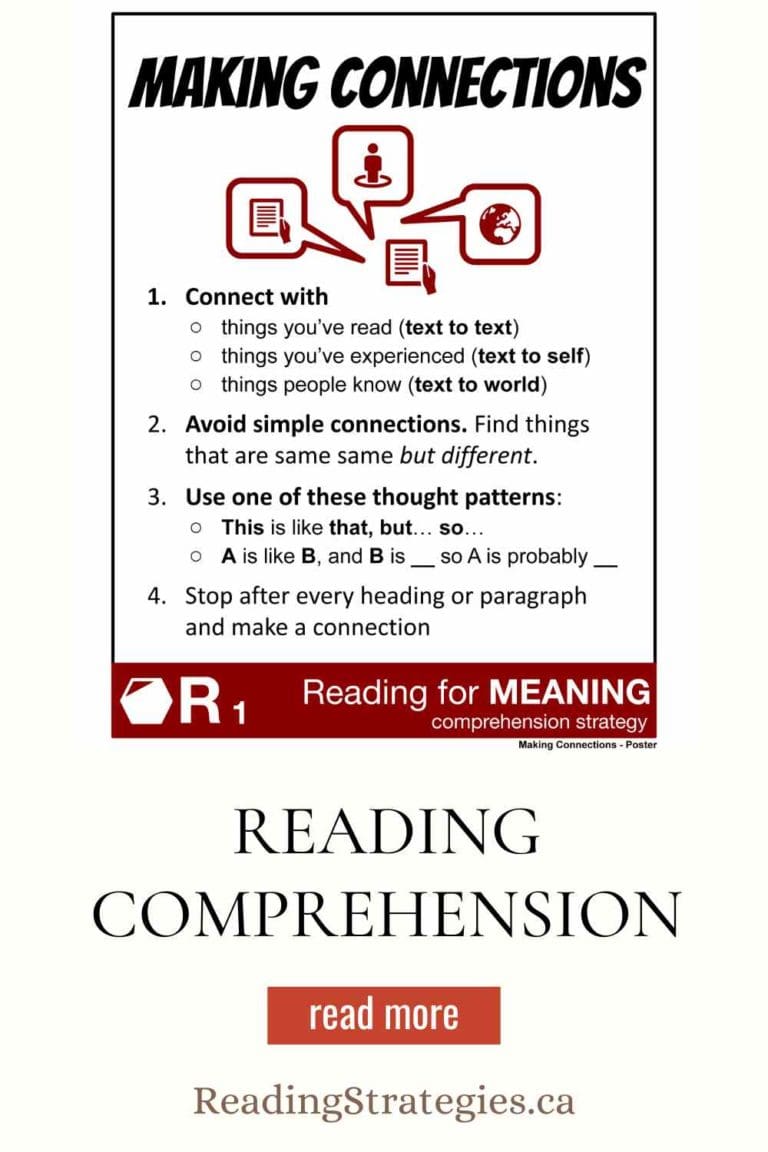
Making Connections Reading Strategy Lesson Plan: How to make deeper Text-to-Self, Text-to-Text, and Text-to-World connections
Making Connections is more than simply finding something that the text reminds you of.
Use this lesson to help your students develop deeper connections instead of thin connections like “this book has a dog and I have a dog…”
How to Make (Deeper) Connections – 4 PRO TIPS:
1. Connect with things you’ve read (text to text), things you’ve experienced (text to self), or things people know (text to world)
2. Avoid simple connections. Find things that are same-same but different.
3. Use one of these thought patterns: “This is like that, but… so…” or “A is like B, and B is _ so A is probably _”
4. Stop after every heading or paragraph and make a connection
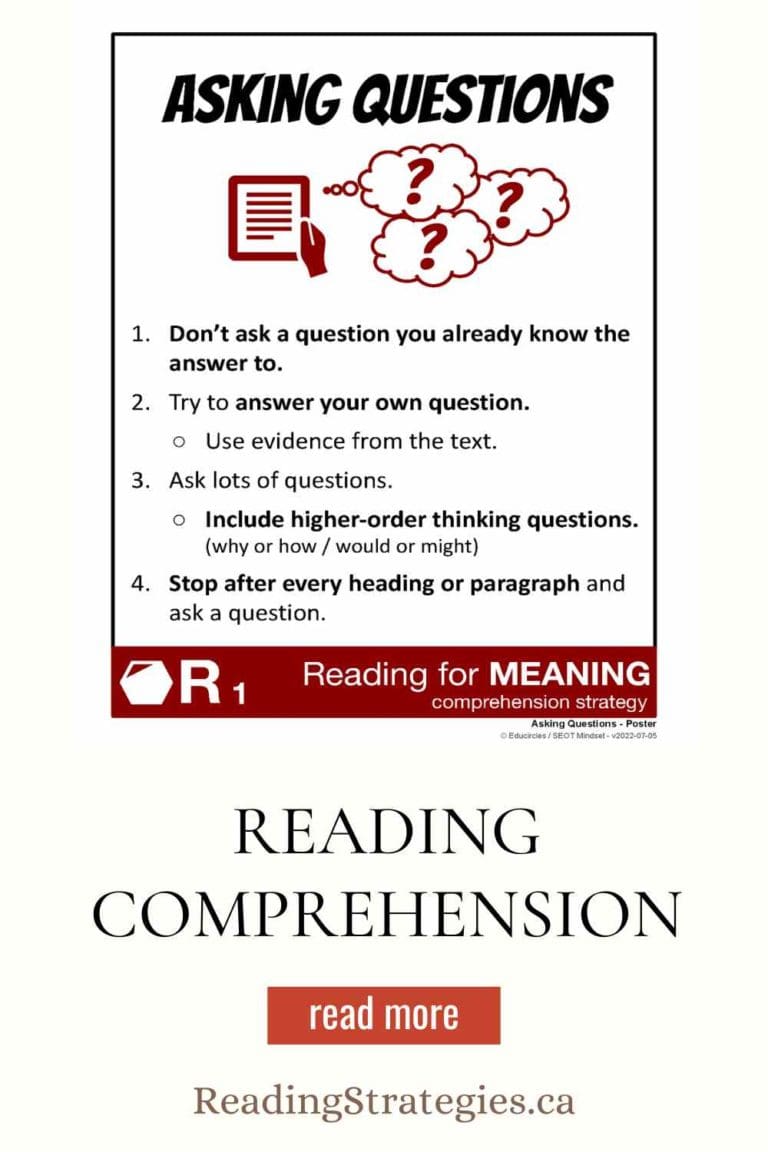
Asking Questions Reading Strategy
Teach 4 PRO TIPS to help students ask the BEST questions when reading to improve comprehension.
High-interest video / slideshow lesson – perfect for your next English Language Arts class.
Students learn how to ask better questions, so they stay engaged while they read.
Active reading strategies can show students how to gain a deeper understanding of the text they’re reading.
How to Ask (Better) Questions – 4 PRO TIPS
1. Don’t ask a question you already know the answer to.
2. Try to answer your own question. Use evidence from the text.
3. Ask lots of questions. Include higher-order thinking questions (why or how / would or might)
4. Stop after every heading or paragraph and ask a question.
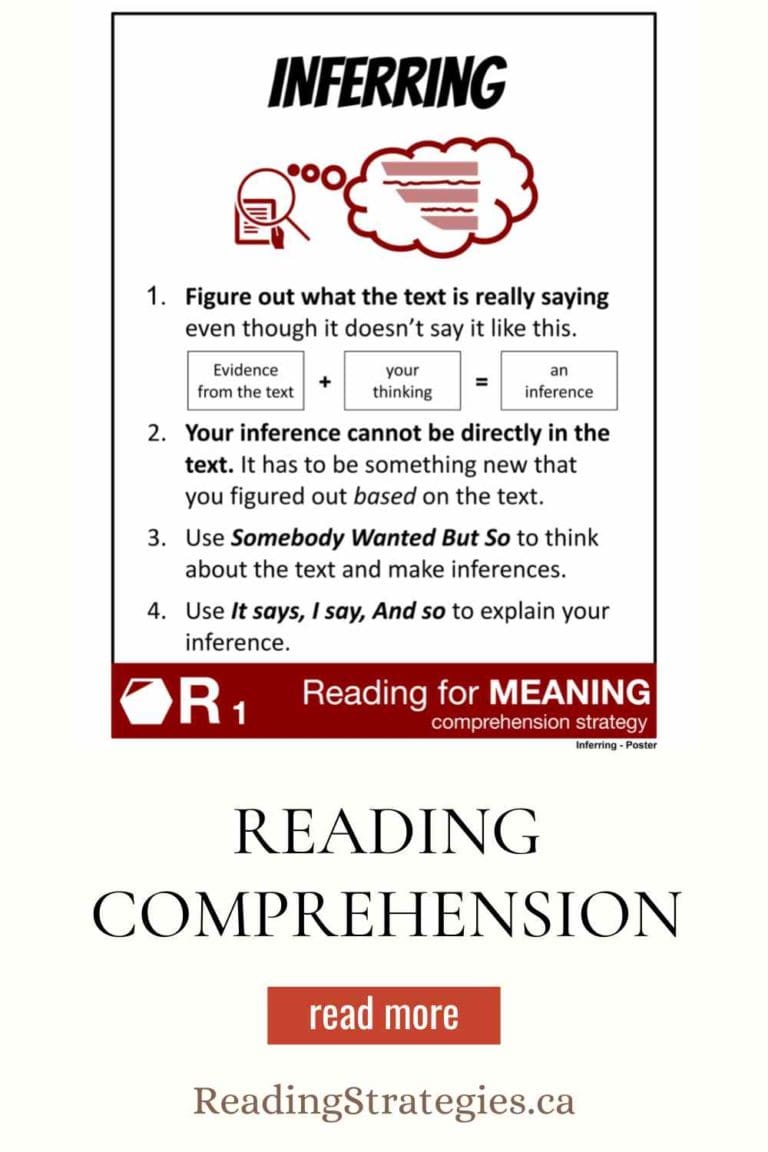
Inferring Reading Strategy Lesson Plan (Inferencing)
Inferring is more than simply reading between the lines.
Use this lesson to help students develop stronger inferences by showing them HOW to come up with an inference, and HOW to check their inference to make it stronger.
How to Infer – 4 PRO TIPS
1. Figure out what the text is really saying even though it doesn’t say it like this. (Evidence from the Text + Your Thinking = an Inference)
2. Your inference cannot be directly in the text. It has to be something new that you figured out based on the text.
3. Use Somebody Wanted But So to think about the text and make inferences.
4. Use It says, I say, And so to explain your inference.
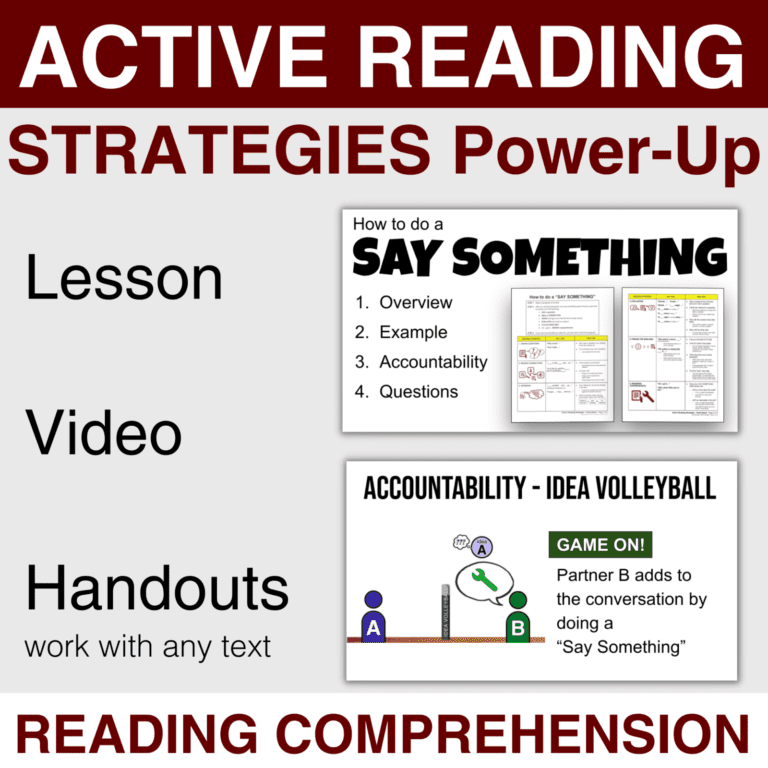
Active Reading Strategies Lesson – Power Up Tool Kit
The Active Reading Strategies Lesson includes strategies and handouts that work with any text! UPDATE: Dec 19, 2022 Improve reading comprehension with just the click of a button! (No, obviously not. But, Evaluating is one of the reading strategies explored in the “Say Something” handout.) FREE until Dec 19, 2022 at 11:59 PM Part 1….
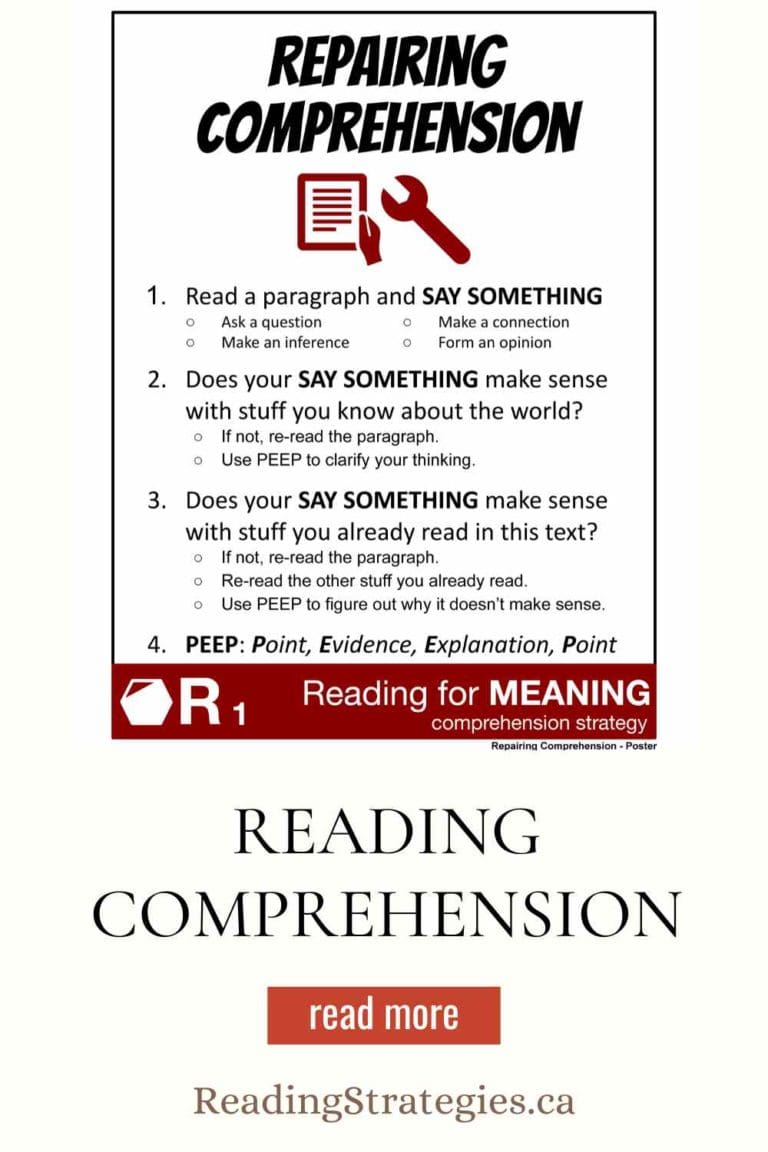
Repairing Comprehension Reading Strategy Lesson Plan
Teach students HOW to monitor understanding and clarify thinking when reading.
There’s more to figuring out what’s going on in a text than just simply re-reading.
4 PRO TIPS: How to Monitor and Repair Comprehension
1. Read a paragraph and SAY SOMETHING: Ask a question, Make a connection, Make an inference, Form an opinion
2. Does your SAY SOMETHING make sense with stuff you know about the world? If not, re-read the paragraph. Use PEEP to clarify your thinking.
3. Does your SAY SOMETHING make sense with stuff you already read in this text? If not, re-read the paragraph. Re-read the other stuff you already read.Use PEEP to figure out why it doesn’t make sense.
4. Use PEEP: Point, Evidence, Explanation, Point
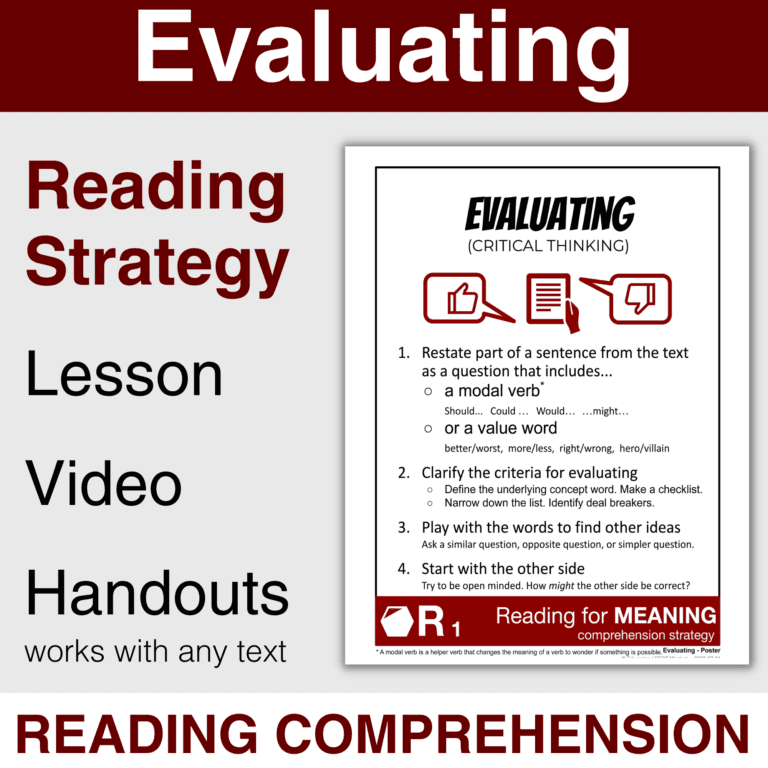
Evaluating Reading Strategy Lesson Plan
Teach students CRITICAL THINKING strategies to help students EVALUATE ideas when reading.
Evaluating is more than just forming an opinion. It’s about making an informed opinion or decision.
Use this lesson to give students a process to help them think critically about the information they read.
4 PRO TIPS to use the Evaluating Reading Strategy:
1. Restate part of a sentence from the text as a question that includes… a modal verb (Should… Could … Would… …might…) or a value word (better/worst, more/less, etc…)
2. Clarify the criteria for evaluating. Define the underlying concept word. Make a checklist. Narrow down the list. Identify deal breakers.
3. Play with the words to find other ideas. Ask a similar question, opposite question, or simpler question.
4. Start with the other side. Try to be open-minded. How might the other side be correct?
popular searches
- Request Info
Finding the Main Idea
The main idea of a paragraph is the author's message about the topic. It is often expressed directly or it can be implied. Knowing how to find main ideas allows you to understand and think critically about what you're reading. And that benefits you regardless of your chosen profession.
Where Are The Main Ideas Found?
It is easy to identify a main idea that is directly expressed in the text. Main ideas are often found:
- at the beginning of paragraphs. The first sentence often explains the subject being discussed in the passage.
- in the concluding sentences of a paragraph. The main idea can be expressed as a summation of the information in the paragraph as well as a link to the information in the next paragraph.
The main idea is not always clearly stated. It is more difficult to identify a main idea when it is inferred or implied. It can be implied through other words in the paragraph. An implied main idea can be found in several ways.
- Several sentences in a paragraph can imply the main idea by introducing facts about the topic before actually stating the topic.
- Implied ideas can be drawn from facts, reasons, or examples that give hints or suggestions concerning the main idea. These hints will be clues leading you to discover the main idea in the selected text.
- Try the passage below to see if you can pick out the main idea. "To many parents, the infant's crying may be mainly an irritation, especially if it continues for long periods. But crying serves important functions for the child as well as for the parents. For the child, crying helps improve lung capacity and the respiratory system. Perhaps more important, the cry serves as a signal of distress. When babies cry, they indicate that they are hungry or in pain, and this is important information for parents."
Use the hints below to determine the correct main idea of this paragraph.
After reading a paragraph ask, "What point is the author making in this passage?"
Ask the following questions:
- Who - Does this passage discuss a person or group of people?
- When - Does the information contain a reference to time?
- Where - Does the text name a place?
- Why - Do you find a reason or explanation for something that happened?
- How - Does this information indicate a method or a theory?
How To Determine If I Have Selected the Correct Main Idea of a Paragraph?
If you are able to summarize the information in the passage in your own words,you have absorbed the correct main idea. To accomplish this goal, try the steps listed below after reading a short section of your textbook.
- Write a short summary in your own words about what you have read.
- Does your summary agree with this general topic?
- Does your summary contain the same ideas being expressed by the author?
- Could you write a headline (or textbook subheading) that would express your summary in less than five words?
If you are able to rephrase your choice of a topic sentence into a question and then determine if the passage answers your question, you have been successful at selecting a main idea.
Other Writing Resources
Enhance your academic writing skills by exploring our additional writing resources that will help you craft compelling essays, research papers, and more.

Your New Chapter Starts Wherever You Are
The support you need and education you deserve, no matter where life leads.
because a future built by you is a future built for you.
Too many people have been made to feel that higher education isn’t a place for them— that it is someone else’s dream. But we change all that. With individualized attention and ongoing support, we help you write a new story for the future where you play the starring role.

Thesis Statements
What this handout is about.
This handout describes what a thesis statement is, how thesis statements work in your writing, and how you can craft or refine one for your draft.
Introduction
Writing in college often takes the form of persuasion—convincing others that you have an interesting, logical point of view on the subject you are studying. Persuasion is a skill you practice regularly in your daily life. You persuade your roommate to clean up, your parents to let you borrow the car, your friend to vote for your favorite candidate or policy. In college, course assignments often ask you to make a persuasive case in writing. You are asked to convince your reader of your point of view. This form of persuasion, often called academic argument, follows a predictable pattern in writing. After a brief introduction of your topic, you state your point of view on the topic directly and often in one sentence. This sentence is the thesis statement, and it serves as a summary of the argument you’ll make in the rest of your paper.
What is a thesis statement?
A thesis statement:
- tells the reader how you will interpret the significance of the subject matter under discussion.
- is a road map for the paper; in other words, it tells the reader what to expect from the rest of the paper.
- directly answers the question asked of you. A thesis is an interpretation of a question or subject, not the subject itself. The subject, or topic, of an essay might be World War II or Moby Dick; a thesis must then offer a way to understand the war or the novel.
- makes a claim that others might dispute.
- is usually a single sentence near the beginning of your paper (most often, at the end of the first paragraph) that presents your argument to the reader. The rest of the paper, the body of the essay, gathers and organizes evidence that will persuade the reader of the logic of your interpretation.
If your assignment asks you to take a position or develop a claim about a subject, you may need to convey that position or claim in a thesis statement near the beginning of your draft. The assignment may not explicitly state that you need a thesis statement because your instructor may assume you will include one. When in doubt, ask your instructor if the assignment requires a thesis statement. When an assignment asks you to analyze, to interpret, to compare and contrast, to demonstrate cause and effect, or to take a stand on an issue, it is likely that you are being asked to develop a thesis and to support it persuasively. (Check out our handout on understanding assignments for more information.)
How do I create a thesis?
A thesis is the result of a lengthy thinking process. Formulating a thesis is not the first thing you do after reading an essay assignment. Before you develop an argument on any topic, you have to collect and organize evidence, look for possible relationships between known facts (such as surprising contrasts or similarities), and think about the significance of these relationships. Once you do this thinking, you will probably have a “working thesis” that presents a basic or main idea and an argument that you think you can support with evidence. Both the argument and your thesis are likely to need adjustment along the way.
Writers use all kinds of techniques to stimulate their thinking and to help them clarify relationships or comprehend the broader significance of a topic and arrive at a thesis statement. For more ideas on how to get started, see our handout on brainstorming .
How do I know if my thesis is strong?
If there’s time, run it by your instructor or make an appointment at the Writing Center to get some feedback. Even if you do not have time to get advice elsewhere, you can do some thesis evaluation of your own. When reviewing your first draft and its working thesis, ask yourself the following :
- Do I answer the question? Re-reading the question prompt after constructing a working thesis can help you fix an argument that misses the focus of the question. If the prompt isn’t phrased as a question, try to rephrase it. For example, “Discuss the effect of X on Y” can be rephrased as “What is the effect of X on Y?”
- Have I taken a position that others might challenge or oppose? If your thesis simply states facts that no one would, or even could, disagree with, it’s possible that you are simply providing a summary, rather than making an argument.
- Is my thesis statement specific enough? Thesis statements that are too vague often do not have a strong argument. If your thesis contains words like “good” or “successful,” see if you could be more specific: why is something “good”; what specifically makes something “successful”?
- Does my thesis pass the “So what?” test? If a reader’s first response is likely to be “So what?” then you need to clarify, to forge a relationship, or to connect to a larger issue.
- Does my essay support my thesis specifically and without wandering? If your thesis and the body of your essay do not seem to go together, one of them has to change. It’s okay to change your working thesis to reflect things you have figured out in the course of writing your paper. Remember, always reassess and revise your writing as necessary.
- Does my thesis pass the “how and why?” test? If a reader’s first response is “how?” or “why?” your thesis may be too open-ended and lack guidance for the reader. See what you can add to give the reader a better take on your position right from the beginning.
Suppose you are taking a course on contemporary communication, and the instructor hands out the following essay assignment: “Discuss the impact of social media on public awareness.” Looking back at your notes, you might start with this working thesis:
Social media impacts public awareness in both positive and negative ways.
You can use the questions above to help you revise this general statement into a stronger thesis.
- Do I answer the question? You can analyze this if you rephrase “discuss the impact” as “what is the impact?” This way, you can see that you’ve answered the question only very generally with the vague “positive and negative ways.”
- Have I taken a position that others might challenge or oppose? Not likely. Only people who maintain that social media has a solely positive or solely negative impact could disagree.
- Is my thesis statement specific enough? No. What are the positive effects? What are the negative effects?
- Does my thesis pass the “how and why?” test? No. Why are they positive? How are they positive? What are their causes? Why are they negative? How are they negative? What are their causes?
- Does my thesis pass the “So what?” test? No. Why should anyone care about the positive and/or negative impact of social media?
After thinking about your answers to these questions, you decide to focus on the one impact you feel strongly about and have strong evidence for:
Because not every voice on social media is reliable, people have become much more critical consumers of information, and thus, more informed voters.
This version is a much stronger thesis! It answers the question, takes a specific position that others can challenge, and it gives a sense of why it matters.
Let’s try another. Suppose your literature professor hands out the following assignment in a class on the American novel: Write an analysis of some aspect of Mark Twain’s novel Huckleberry Finn. “This will be easy,” you think. “I loved Huckleberry Finn!” You grab a pad of paper and write:
Mark Twain’s Huckleberry Finn is a great American novel.
You begin to analyze your thesis:
- Do I answer the question? No. The prompt asks you to analyze some aspect of the novel. Your working thesis is a statement of general appreciation for the entire novel.
Think about aspects of the novel that are important to its structure or meaning—for example, the role of storytelling, the contrasting scenes between the shore and the river, or the relationships between adults and children. Now you write:
In Huckleberry Finn, Mark Twain develops a contrast between life on the river and life on the shore.
- Do I answer the question? Yes!
- Have I taken a position that others might challenge or oppose? Not really. This contrast is well-known and accepted.
- Is my thesis statement specific enough? It’s getting there–you have highlighted an important aspect of the novel for investigation. However, it’s still not clear what your analysis will reveal.
- Does my thesis pass the “how and why?” test? Not yet. Compare scenes from the book and see what you discover. Free write, make lists, jot down Huck’s actions and reactions and anything else that seems interesting.
- Does my thesis pass the “So what?” test? What’s the point of this contrast? What does it signify?”
After examining the evidence and considering your own insights, you write:
Through its contrasting river and shore scenes, Twain’s Huckleberry Finn suggests that to find the true expression of American democratic ideals, one must leave “civilized” society and go back to nature.
This final thesis statement presents an interpretation of a literary work based on an analysis of its content. Of course, for the essay itself to be successful, you must now present evidence from the novel that will convince the reader of your interpretation.
Works consulted
We consulted these works while writing this handout. This is not a comprehensive list of resources on the handout’s topic, and we encourage you to do your own research to find additional publications. Please do not use this list as a model for the format of your own reference list, as it may not match the citation style you are using. For guidance on formatting citations, please see the UNC Libraries citation tutorial . We revise these tips periodically and welcome feedback.
Anson, Chris M., and Robert A. Schwegler. 2010. The Longman Handbook for Writers and Readers , 6th ed. New York: Longman.
Lunsford, Andrea A. 2015. The St. Martin’s Handbook , 8th ed. Boston: Bedford/St Martin’s.
Ramage, John D., John C. Bean, and June Johnson. 2018. The Allyn & Bacon Guide to Writing , 8th ed. New York: Pearson.
Ruszkiewicz, John J., Christy Friend, Daniel Seward, and Maxine Hairston. 2010. The Scott, Foresman Handbook for Writers , 9th ed. Boston: Pearson Education.
You may reproduce it for non-commercial use if you use the entire handout and attribute the source: The Writing Center, University of North Carolina at Chapel Hill
Make a Gift
- Food & Dining
- Coronavirus
- Real Estate
- Seattle History
- PNW Politics
Thesis Statements vs. Main Ideas
Related articles, how to write a unified essay, what is a circular narrative style, what narrative point of view is used in "and then there were none".
- Teacher Tips: How to Write Thesis Statements for High School Papers
- Explanation on Theme in Literature for Students
The thesis statement is a one-sentence statement that expresses the main idea of the essay. The thesis statement is an arguable statement that communicates the author’s stance on a topic to the reader. In order to better understand the differences between a thesis statement and main idea, it's important to understand the components of an essay. Essentially, it's not a “versus” situation because the thesis statement and main idea cannot exist without the other.
Purpose of the Thesis Statement
The thesis statement is the foundation of the essay because it tells the reader what the essay will be about and gives the essay direction. The goals of the thesis statement are to organize and development your argument and provide your reader with a road map or guide to your argument. The thesis statement should answer a question about the topic you are exploring as a writer. A good thesis statement will express only one main idea and will assert your conclusion about a topic.
Identifying the Main Idea
If you are given a topic to write about, it's important to first do your research and identify some main ideas associated with that topic. If you are writing about a piece of literature or specific work, you'll still need to do research but you will also need to read for key concepts or key ideas within that piece of writing first. Consider rereading the piece of literature to locate the main idea of the writer. Once you have located the main idea, you can then generate an opinion about the idea and create your thesis statement.
Developing the Main Idea
The topic of an essay is the subject, or what the essay is all about. An idea is what the writer says about the topic. The ideas include the main idea, which is then expressed in the form of a thesis statement. The main idea is not arguable like the thesis statement should be; it's simply an idea. Before writing, you should first develop the main idea because you cannot generate an arguable thesis statement about a topic until you have identified what you think of the topic.
Purpose of the Topic Sentence
The main idea of an essay is conveyed through the thesis statement and carried out through the topic sentences. An idea cannot be a statement, but a statement conveys an idea, hence the purpose of a thesis statement to state the point of an idea to convey to the reader in the development of an essay. Topic sentences also express the main idea. It's the first sentence of each subsequent paragraph in the essay and should be followed by supporting details, all supporting the topic sentence, which should support the main idea expressed in the thesis statement.
- Teacher Vision: Establishing the Main Idea
- Indiana University Bloomington: How to Write a Thesis Statement
Alyssa Sellors has been in the field of education for five years, teaching English and journalism at the high school level. In addition to teaching, she has also advised the school newspaper and currently advises the yearbook. As a yearbook adviser, she speaks at national conventions hosted by Journalism Educator’s Association and the National Scholastic Press Association.
What Is a Multi-Paragraph Essay?
How to write a college expository essay, how to start an introduction when writing an essay about poetry, what is the central conflict in "beowulf", what is the difference between an elizabethan & petrarchan sonnet, the importance of writing an effective thesis statement, what are the four tips for writing a good thesis statement for an expository essay, how to write an in-class essay, how to write a thesis statement for an autobiographical essay, most popular.
- 1 What Is a Multi-Paragraph Essay?
- 2 How to Write a College Expository Essay
- 3 How to Start an Introduction When Writing an Essay About Poetry
- 4 What Is the Central Conflict in "Beowulf"?

IMAGES
VIDEO
COMMENTS
For example, a research article's main idea is toward the end, whereas a persuasive essay's main idea is conveyed at the beginning. Steps for Identifying the Main Idea. Step 1. Pre-read to Determine the Overall Topic. Examine the title and then skim the text to determine who or what the reading is about. If you see the same word repeated you ...
The main idea is what a passage is about and answers the question: what is being discussed? Learn how to pinpoint main ideas with a few simple strategies. ... If you were writing an essay for school, the main idea would clearly be written in your thesis statement. There's no guessing the writer's intention with a thesis statement. It's ...
The main idea, thesis statement, and topic sentences all provide structure to an essay. It is important for both readers and writers to understand the roles of each of these in order to maintain ...
The main idea of a paragraph is the primary point or concept that the author wants to communicate to the readers about the topic. Hence, in a paragraph, when the main idea is stated directly, it is expressed in what is called the topic sentence. It gives the overarching idea of what the paragraph is about and is supported by the details in ...
Main Idea. Finding the main idea in a piece of writing is a basic reading skill. No matter what type of expository text you read, the primary comprehension goal is to identify the main idea: the most important point that the writer wants to communicate. Main ideas are often stated toward the start of a text, usually in an introductory paragraph.
Main Idea, Purpose, & Audience. Text evaluation and analysis usually start with the core elements of that text: main idea, purpose, and audience. An author needs to consider all three of these elements before writing, as they help determine the author's content and language. As a reader, it's important to ascertain these aspects of a text ...
3. Restate the main idea in 10 words or less. You can model this strategy for your students by first walking them through the process. Project the text onto the whiteboard for shared reading and, with focused support and prompting, have them answer the initial questions.
Your thesis is the central claim in your essay—your main insight or idea about your source or topic. Your thesis should appear early in an academic essay, followed by a logically constructed argument that supports this central claim. A strong thesis is arguable, which means a thoughtful reader could disagree with it and therefore needs
1.The topic of the paragraph is pyramids. 2. There are three groups of supporting details: age, size, and purpose. 3.The author has organized the supporting details into "characteristics" or "traits" of the pyramids. 4.The author purpose seems to be trying to define a pyramid. Implied Main Idea: Pyramids are structures with several ...
Step 1: Hook your reader. Step 2: Give background information. Step 3: Present your thesis statement. Step 4: Map your essay's structure. Step 5: Check and revise. More examples of essay introductions. Other interesting articles. Frequently asked questions about the essay introduction.
Follow along as we walk through some helpful tips on pinpointing the main idea of a passage. 1. Identify the topic. One of the first tools you can use for locating the main idea is referencing the title of a paper or any subtitles used throughout. Titles are a great way of gaining a grasp on the central topic of an author's argument.
Dynamic PDF: Thesis Statements The thesis statement is perhaps the most crucial part of your essay because it presents the main idea or main argument of the piece of writing. In academic essays, your thesis statement is often located in the introductory paragraph; however, this is not always the case. Consider the rhetorical situation and assignment guidelines to […]
1. The main idea is not a single detail from the passage. Details are the specific pieces of information that support or explain the main idea. For example, if the main idea of a passage is that eating healthy is important, some of the details might include information about the benefits of eating healthy or examples of healthy foods to eat.
Exercise 3.8.1 3.8. 1. Read the following paragraph and then decide what the main idea is. One myth about exercise is that if a woman lifts weights, she will develop muscles as large as a man's. Without male hormones, however, a woman cannot increase her muscle bulk as much as a man's.
Your essay introduction should include three main things, in this order: An opening hook to catch the reader's attention. Relevant background information that the reader needs to know. A thesis statement that presents your main point or argument. The length of each part depends on the length and complexity of your essay.
Narratives and personal essays require a central idea to help focus and direct your writing. For example, consider this topic: Describe an incident in your life that caused you to change an opinion or attitude.Before you begin writing, create a sentence that will both identify the incident and describe the change it caused.
Finding the Main Idea is more than just figuring out what general point the author is trying to make. It's about recognizing that we can come up with several main ideas, but the "best" main idea has strong support from the entire article. ... Finding the Main Idea - Example #4: Now, this essay has 20 paragraphs. A 20-paragraph essay has ...
This handout will define what an argument is and explain why you need one in most of your academic essays. ... In academic writing, an argument is usually a main idea, often called a "claim" or "thesis statement," backed up with evidence that supports the idea. In the majority of college papers, you will need to make some sort of claim ...
It is easy to identify a main idea that is directly expressed in the text. Main ideas are often found: at the beginning of paragraphs. The first sentence often explains the subject being discussed in the passage. in the concluding sentences of a paragraph. The main idea can be expressed as a summation of the information in the paragraph as well ...
An essay is a focused piece of writing designed to inform or persuade. There are many different types of essay, but they are often defined in four categories: argumentative, expository, narrative, and descriptive essays. Argumentative and expository essays are focused on conveying information and making clear points, while narrative and ...
The main point or main idea is generally a one or two sentence summary. With nonfiction, the writer often puts the main idea either in the first paragraph of an essay or in the first sentence of a ...
A thesis statement: tells the reader how you will interpret the significance of the subject matter under discussion. is a road map for the paper; in other words, it tells the reader what to expect from the rest of the paper. directly answers the question asked of you. A thesis is an interpretation of a question or subject, not the subject itself.
The thesis statement is a one-sentence statement that expresses the main idea of the essay. The thesis statement is an arguable statement that communicates the author's stance on a topic to the reader. In order to better understand the differences between a thesis statement and main idea, it's important to understand the components of an essay.